1lumen selects and reviews products personally. We may earn affiliate commissions through our links, which help support our testing.
Speras TH12 review

Speras TH12 specs
| Brand & Model | Speras TH12 |
|---|---|
| Flashlight category | Hunting, long-range flashlight |
| LED | “High Performance S51”, Osram Red, Osram Green |
| Max. output | 600 lumens (white, flood) |
| Max. beam distance | 1680 meters (green, focus) |
| Max. beam intensity | 705,600 cd |
| Battery config. | 1x 18650 |
| Onboard charging | USB-C |
| Main modes | Infinitely variable |
| Blinkies | N/A |
| Waterproof | IP68 |
| Review publication date | July 2023 |
Review intro:
I’ve reviewed a few Speras lights lately. My thoughts? In general, this fairly quiet brand has really impressed me with their overall quality and design. The M2R-35 headlamp and M4 pocket thrower were immediate successes in my mind. The P4, a more EDC-focused light, had good build quality but I wasn’t overly impressed with the driver/electronics. The flashlight we’re reviewing now – the Speras TH12 – is in yet another class. The TH12 is a hunting-oriented zoomable light with multiple LED modules and several accessories geared towards hunters. Initial impressions say that it should live up to the Speras name. But how does it perform?
To get started with the Speras TH12, just open the package, remove the flashlight. Unscrew the tailcap from the light, and then remove the battery isolation disc. Reassemble and you’re ready to rock and roll.
Package quality.
The Speras TH12 kit (sometimes written out as TH12K, presumably for “kit”) arrived in a nice plastic carrying case to house all of the bits and bobs. The case is filled with dense foam with cutouts for all of the accessories. Sadly, the case must have gotten jostled around on its journey and it arrived a bit broken up; one of the latches was busted off. Inside the case was:
- Speras TH12 flashlight
- Battery (18650, in the light)
- USB charging cable
- Remote switch
- Scope clamp
- Two additional LED modules (red and green)
- Lanyard
- Spare o-rings
- Manual
All in all, that’s a really well-rounded kit. And that’s quite a bit of stuff to keep track of, so I am glad that it came arranged nicely in a case.
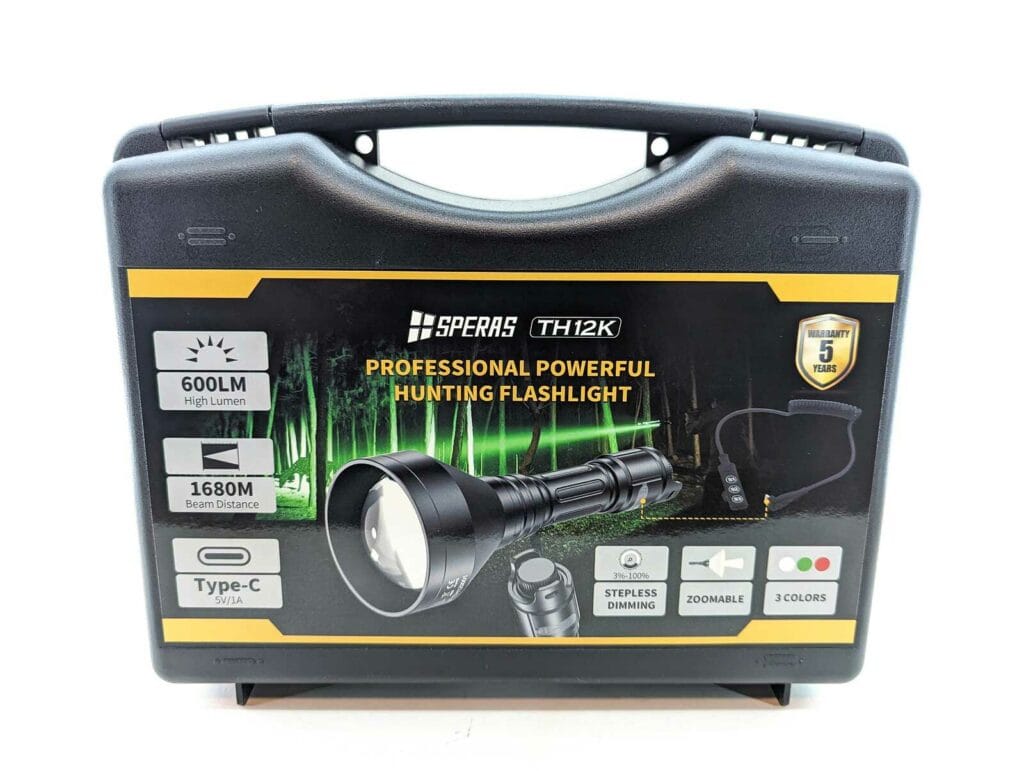
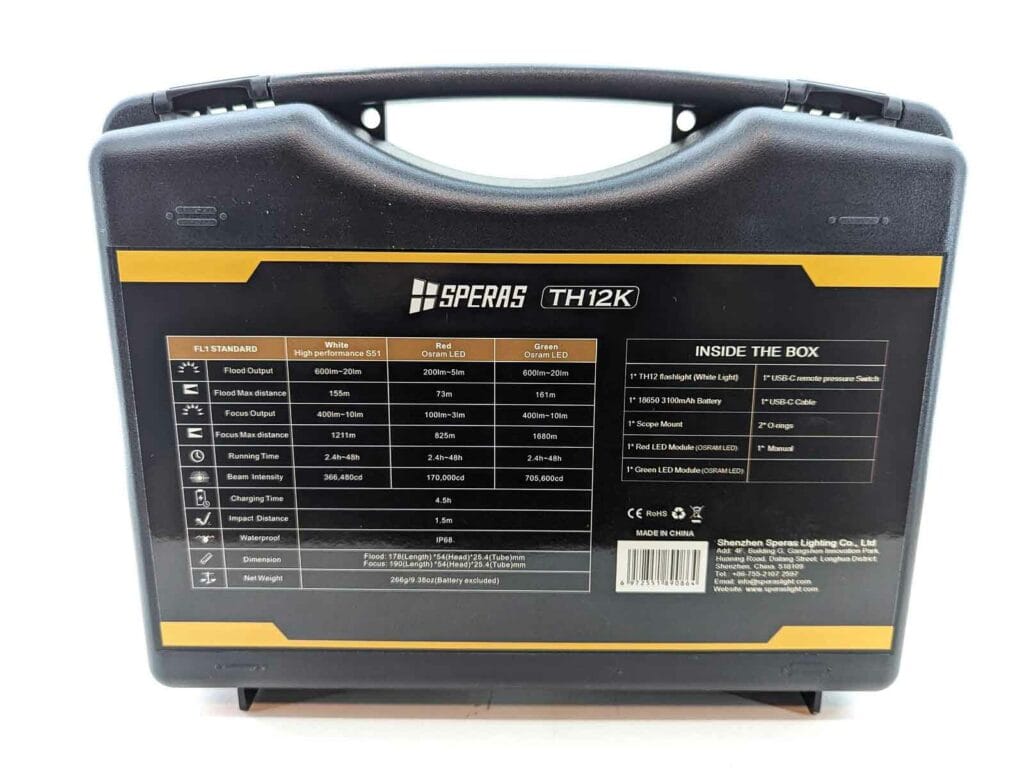
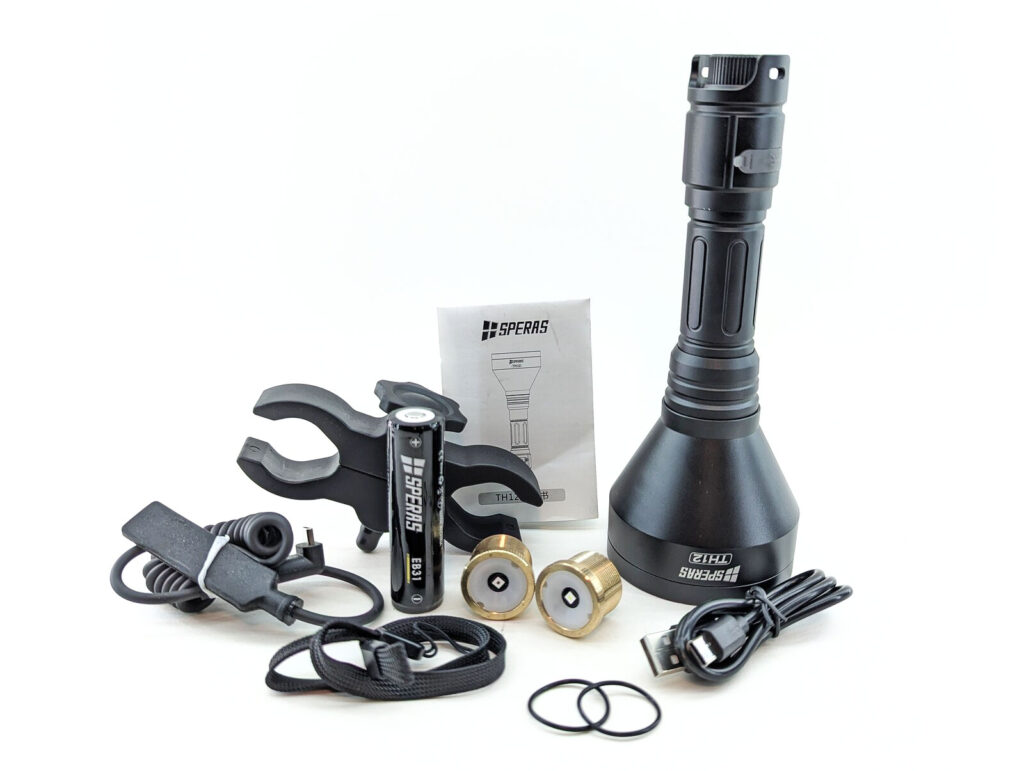
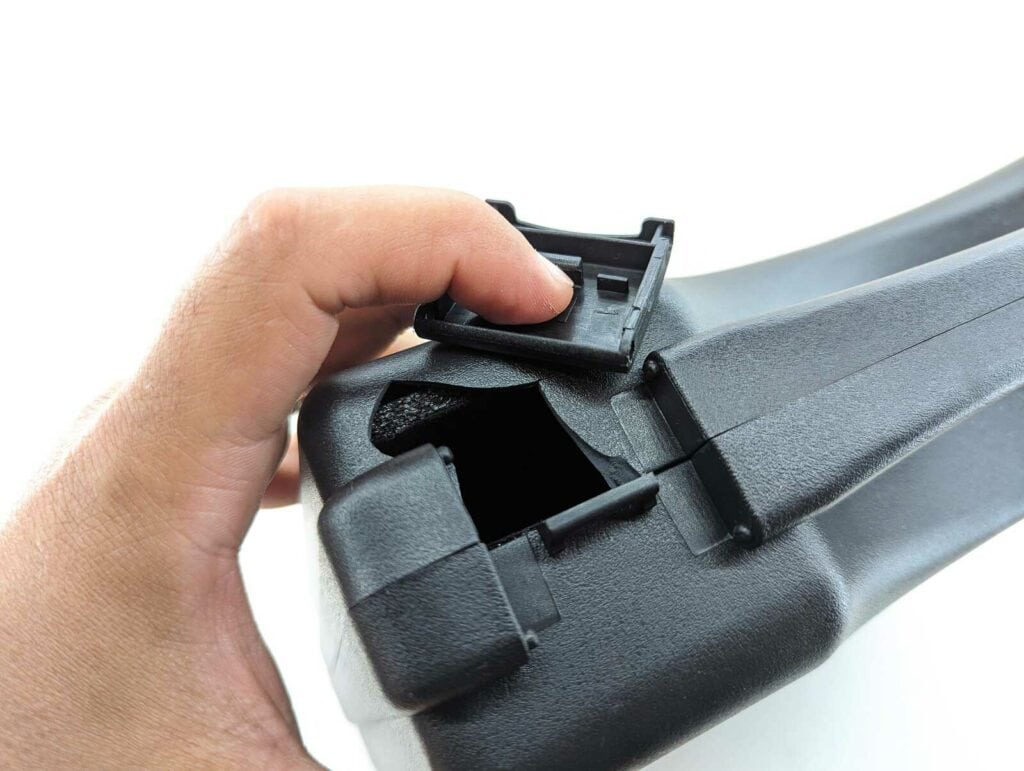
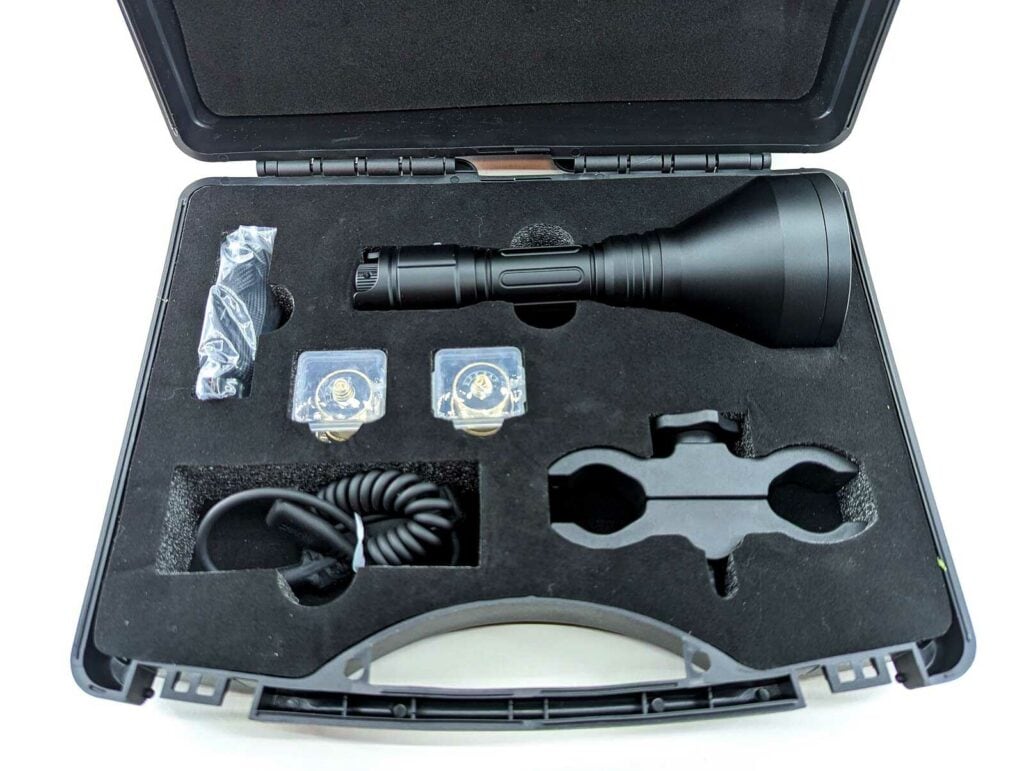
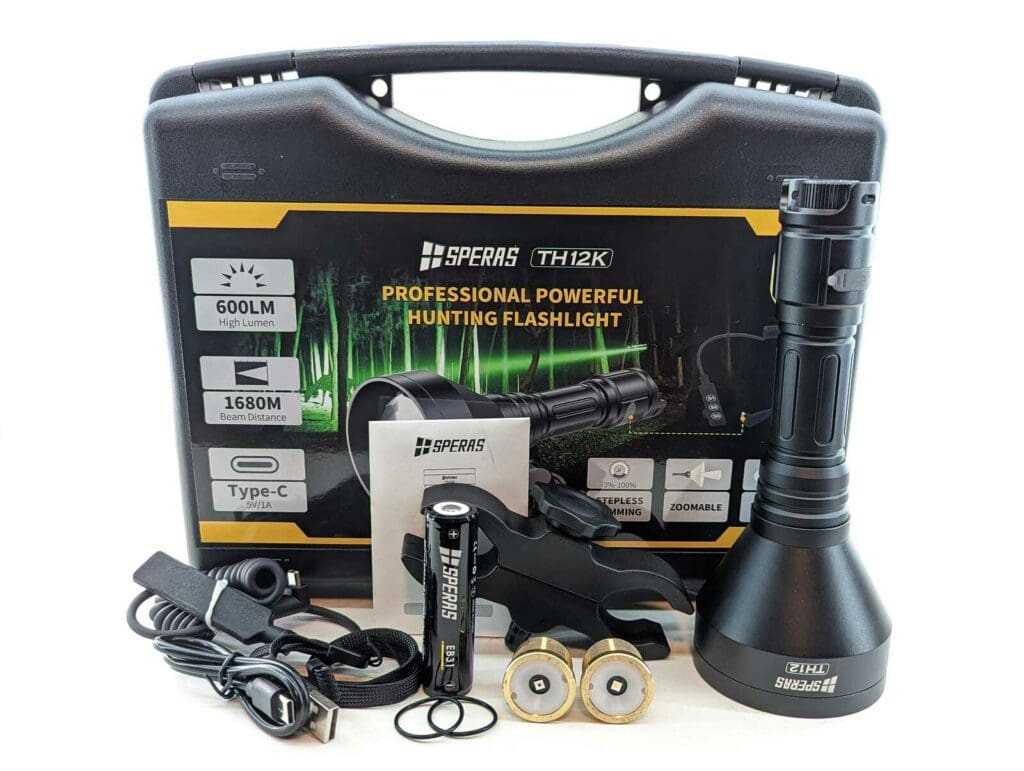
Flashlight in use
It’s been a while since I’ve used an aspheric-lens flashlight, especially with one having a large optic like the Speras TH12 has. The thing is, zoomable lights just don’t seem as common in the enthusiast market as they used to be. That’s probably in part because of the rise of LEP (laser) flashlights – if you want the longest range light, an LEP will fill that need. But sometimes you need/want the flexibility of being able to go between focused and flood, and that’s what a zoomable light brings to the table. Hunting is a good example of where you might want a zoomable light, because your target range may vary from day to day (or even within a single hunting outing).
The TH12 is pretty smooth to hold, there’s no knurling or aggressive patterns. However, there is enough varying thickness and channels in the aluminum to give you a good grip. There’s no pocket clip here, nor should you expect one with the size of the head on this thing. There is a lanyard provided that is of standard quality.
Aside from the multiple LED modules, there are a couple other included accessories that give evidence to the TH12 being a hunting-focused light. The first is the clamp. It’s a pretty standard screw-knob clamp that grips two cylindrical objects; in this instance one would be the TH12 and the other would be a rifle scope. The other hunting accessory is a remote switch that plugs into the light’s USB-C port. The cord has a coil in the middle to allow the length to flex, and the switch module itself consists of three e-switches for controlling on/off/momentary and brighter/dimmer.
Aside from the remote switch, there is only one other switch for the TH12, and that is in the tailcap. It’s pretty unique, though. The switch is an on/off e-switch… think of a tall version of what you might find on the FW3A series of lights. But the switch also twists; it’s a rotary dimmer. The switch setup is neat and seems to work smoothly.
I’ve talked a lot about the Speras TH12 being a hunting light, and it certainly is. But you can definitely use this for pretty much anything you’d want a zoomie light for. Need a smooth, even beam? Check. Want to be able to switch to a focused beam? Done. The TH12 could also be used for things like walking a dog, camping, or scanning the backyard or field for unwanted visitors.
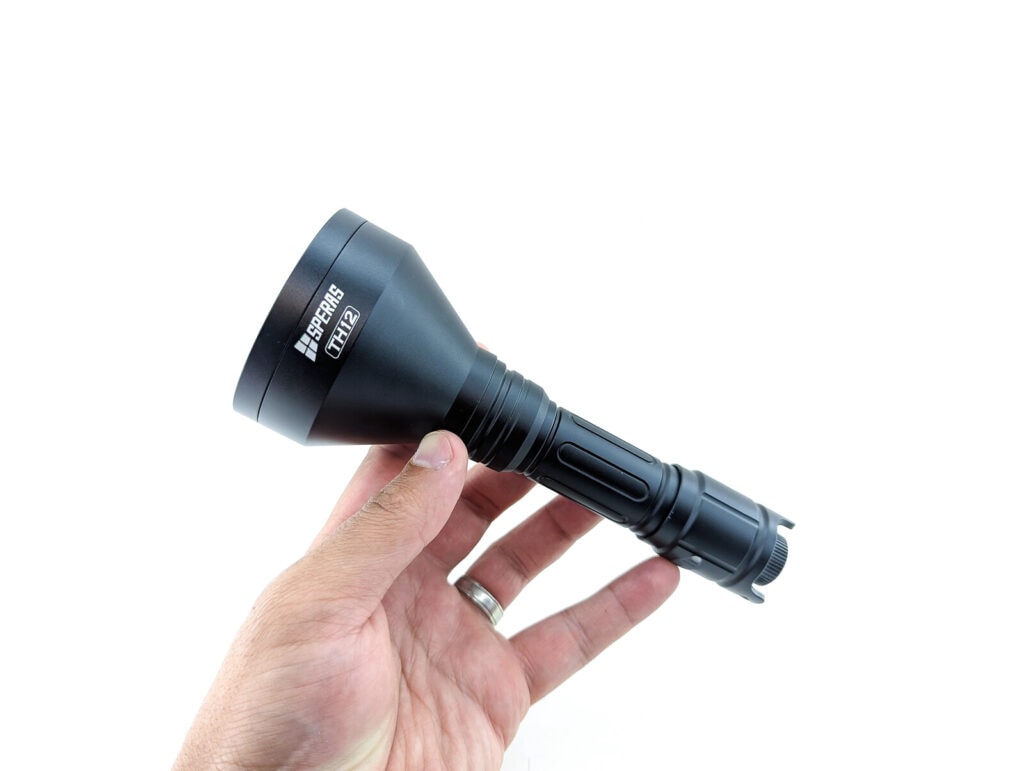
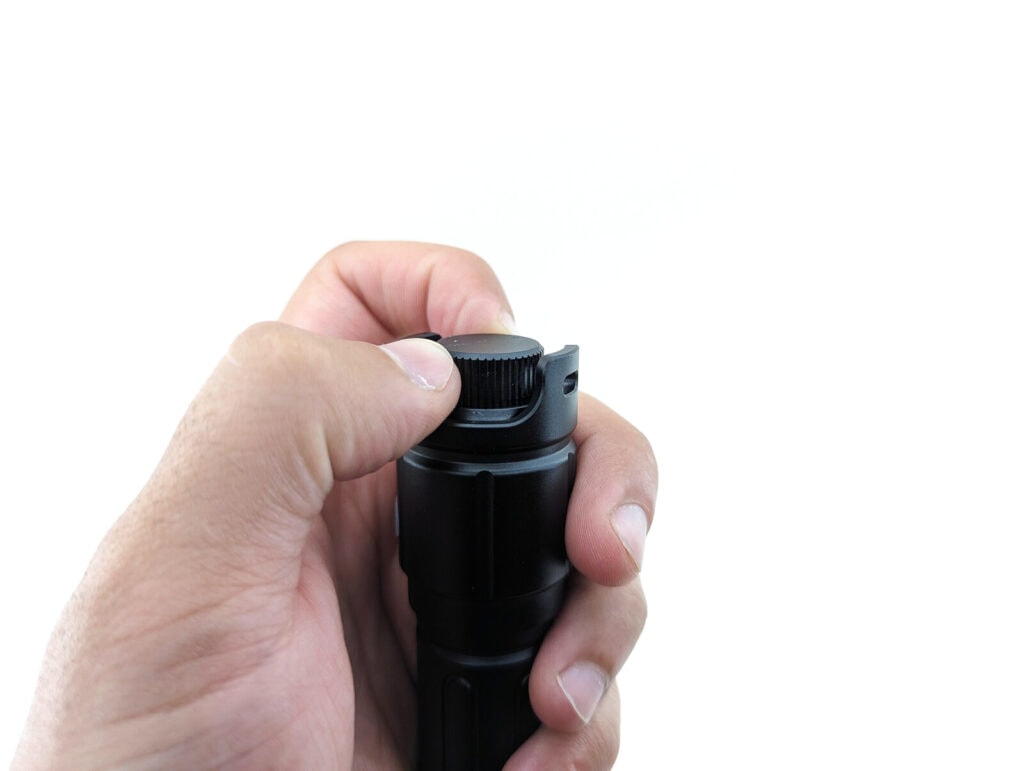
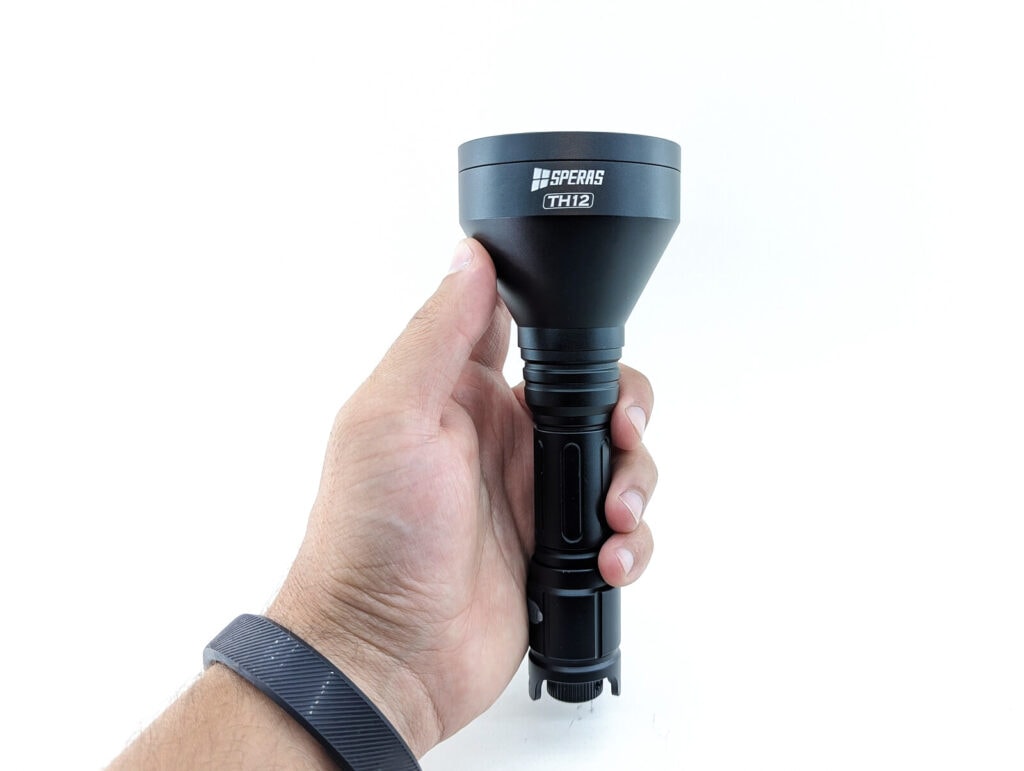
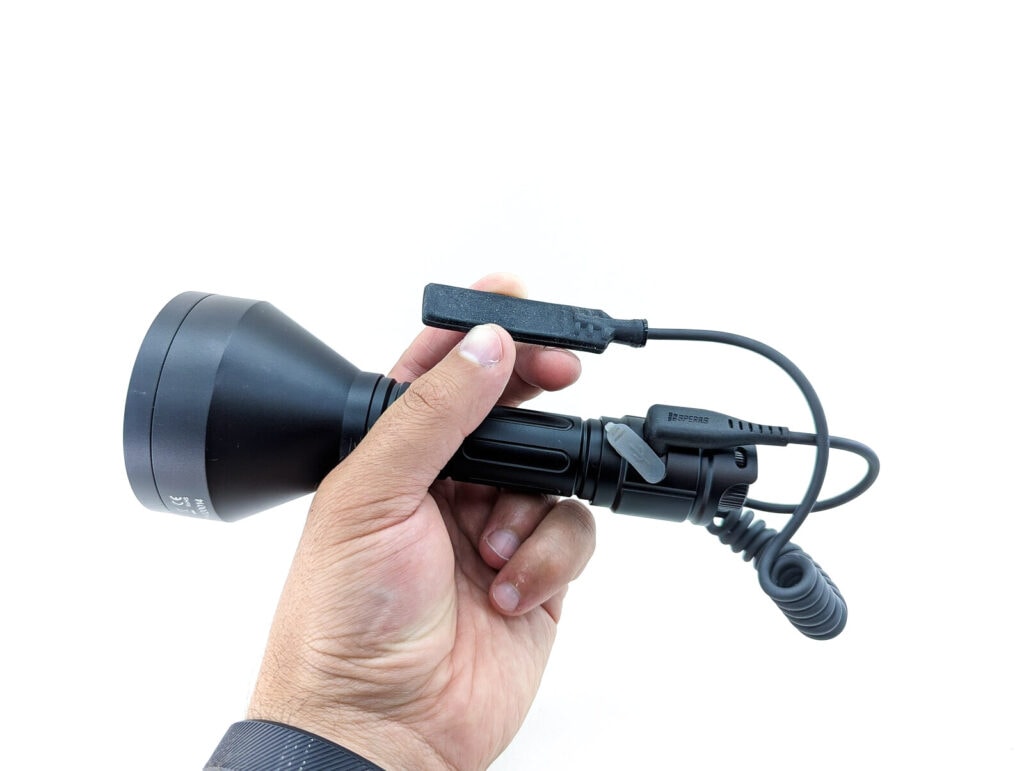
Build Quality and Warranty
Some lights just seems nicer than others. From the moment you pick them up, you can feel it. The anodizing is better (thicker, less glossy). They’ve paid attention to detail on all of the machining, making sure everything lines up perfectly and that there are no sharp edges. And that’s exactly what I’ve found with all of the Speras lights I have reviewed, the TH12 included. It just looks and feels like a nice flashlight. The twist / zoomie action is very smooth and lubed, taking only a quarter turn to fully go from flood to focused. As to be expected, it is constructed out of 6061 aluminum alloy with a premium Type III hard-anodized finish.
Warranty:
- The light is covered by a 5 year warranty for “non-artificial” damage
- The warranty does not cover normal wear & tear, modifications, misuse, etc

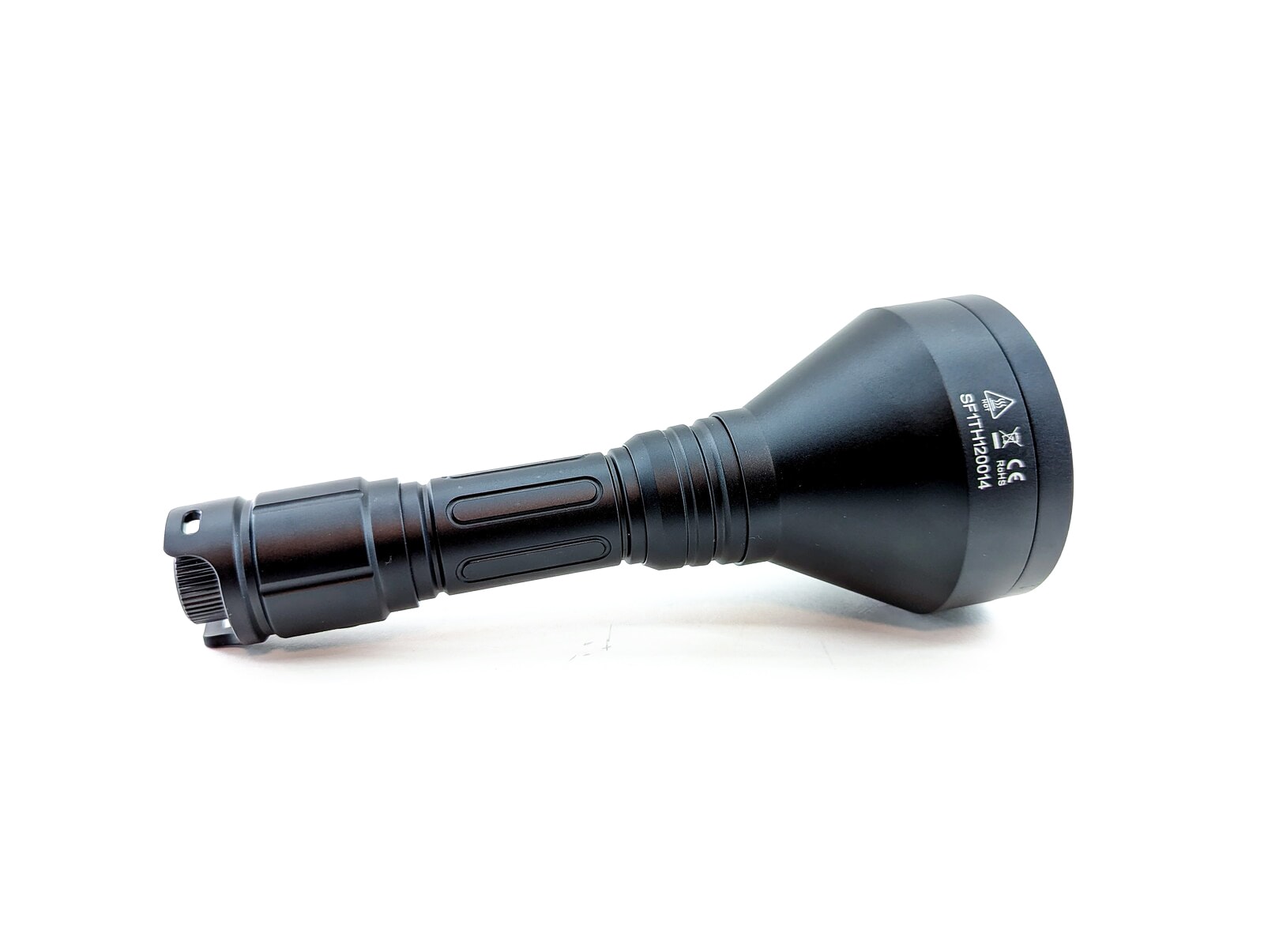
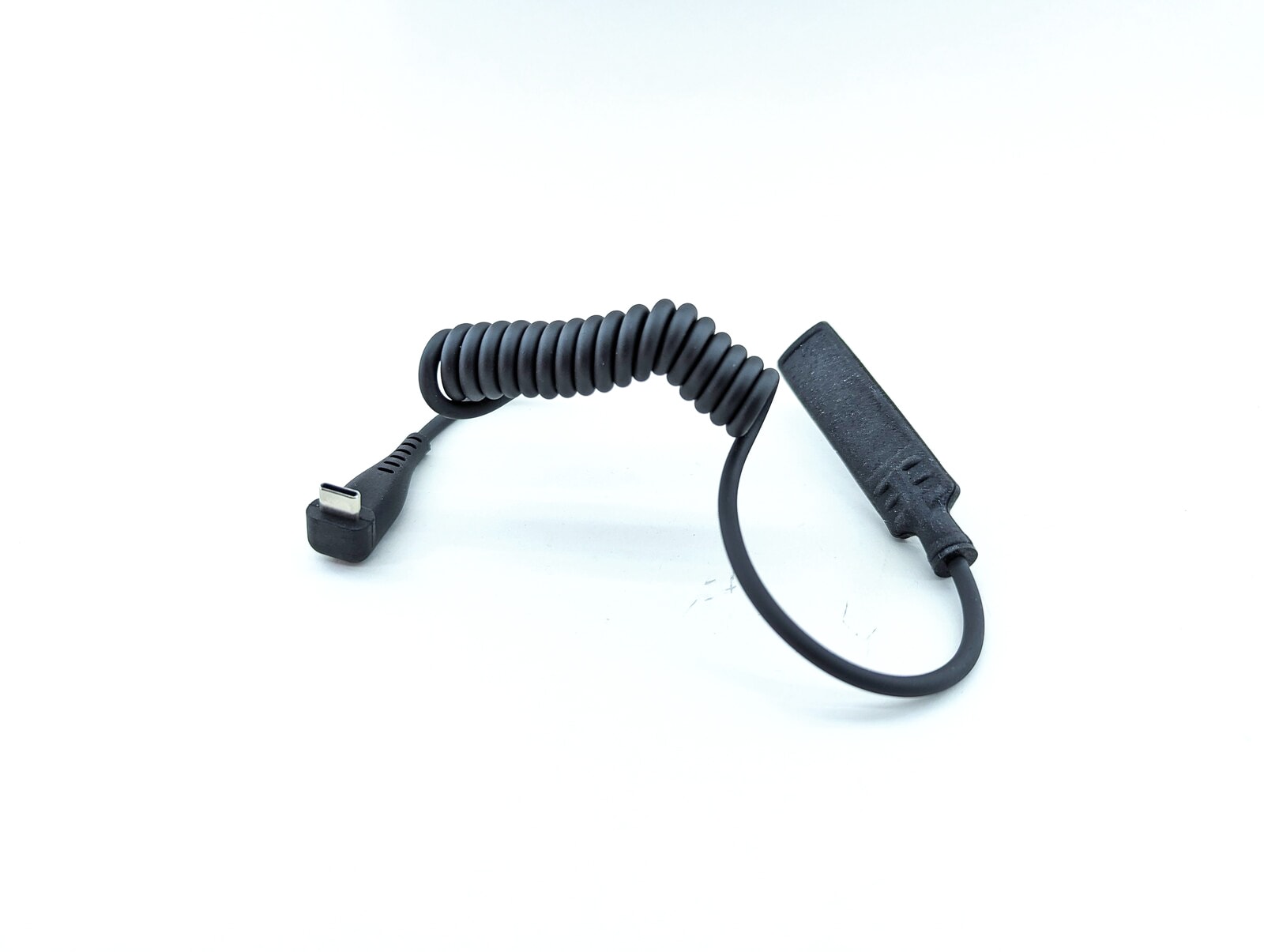
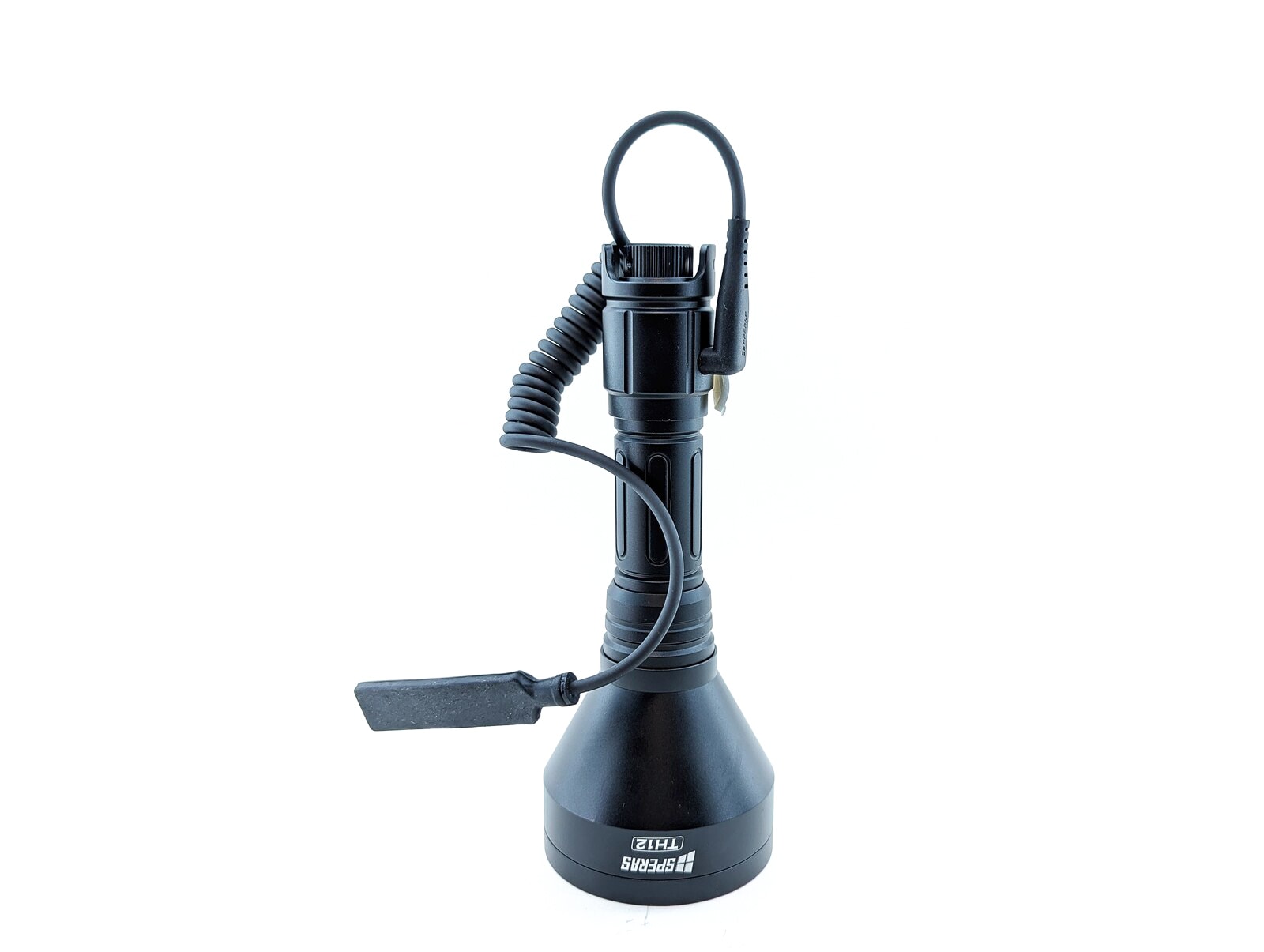
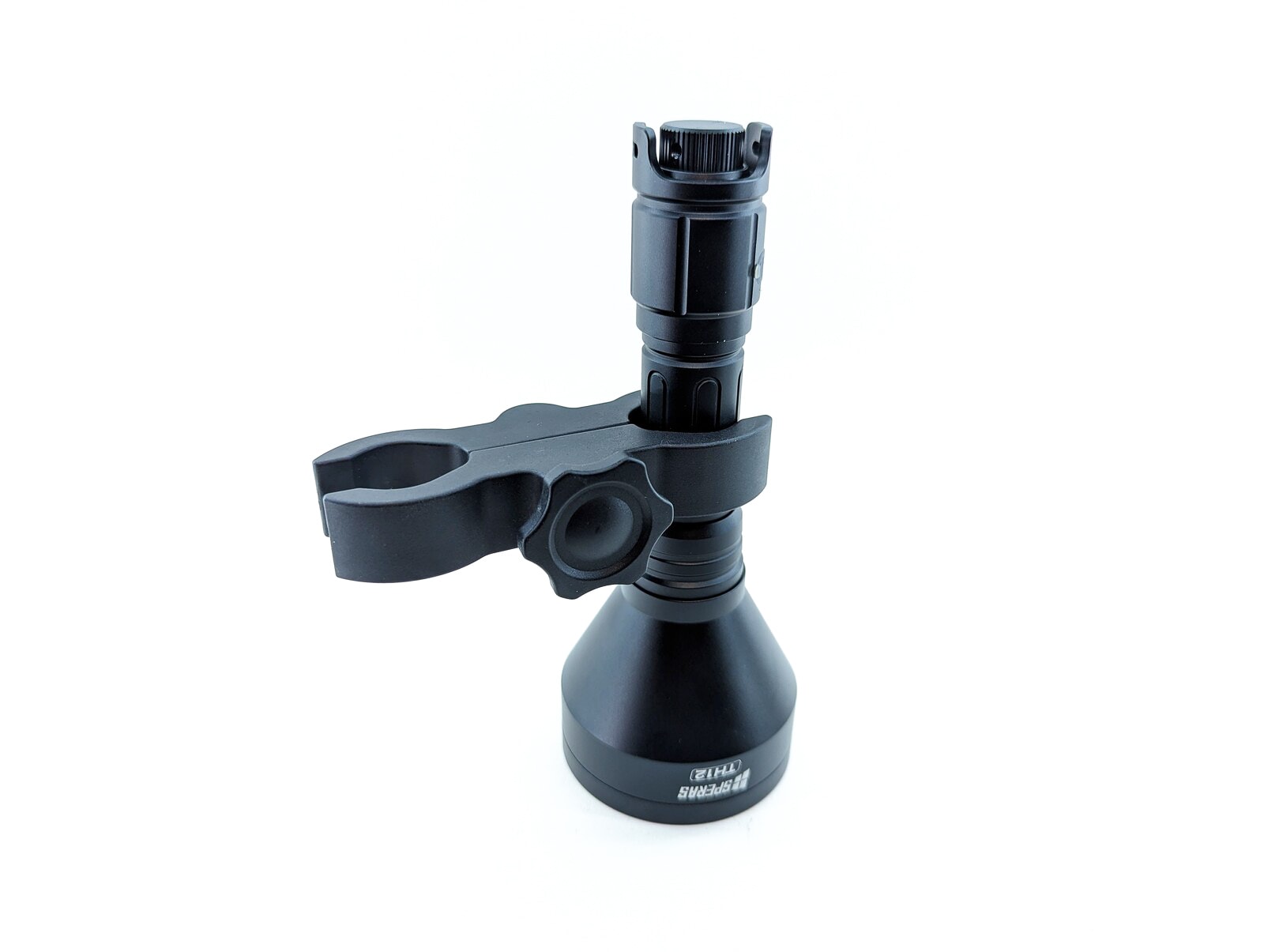
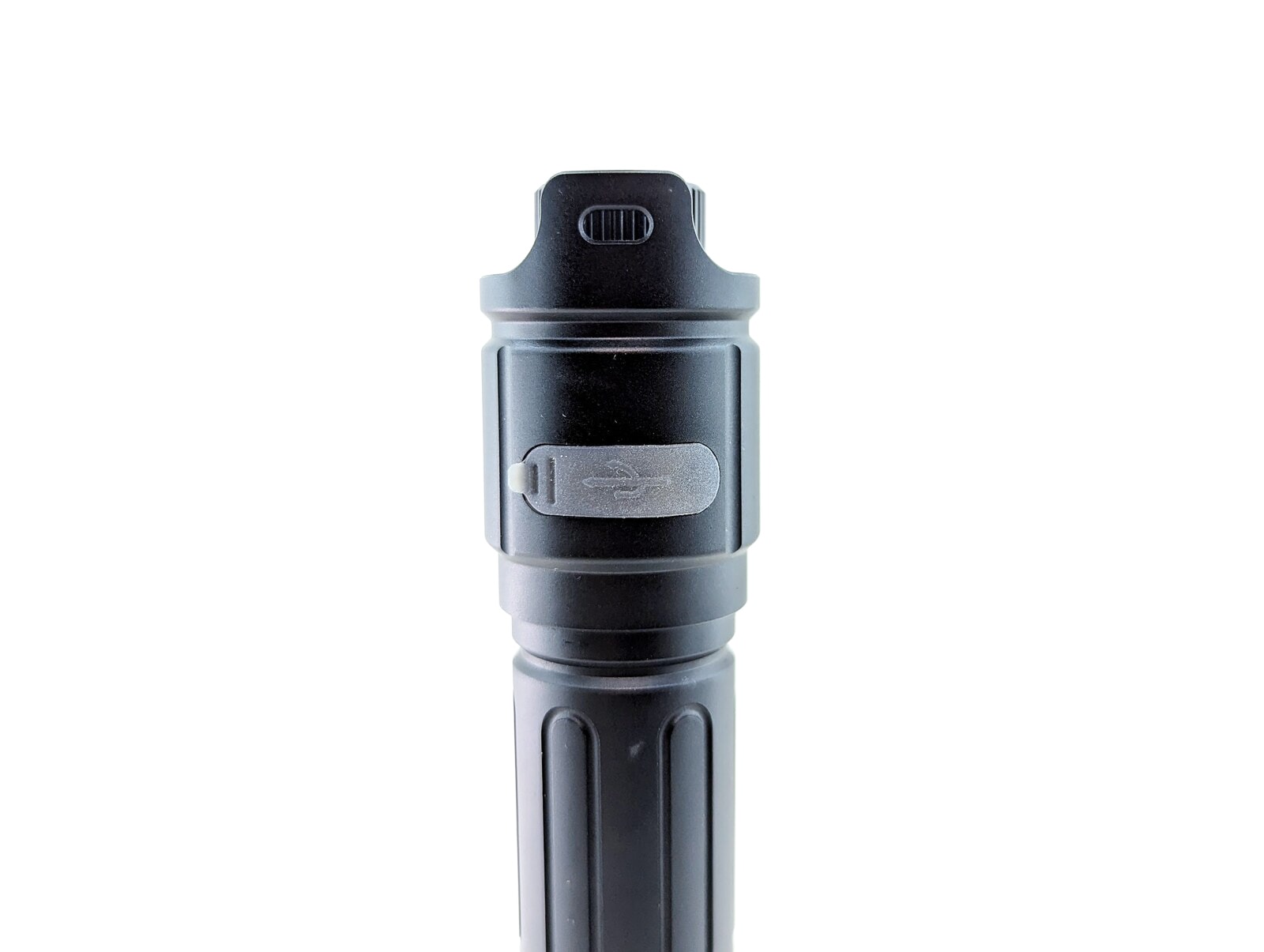
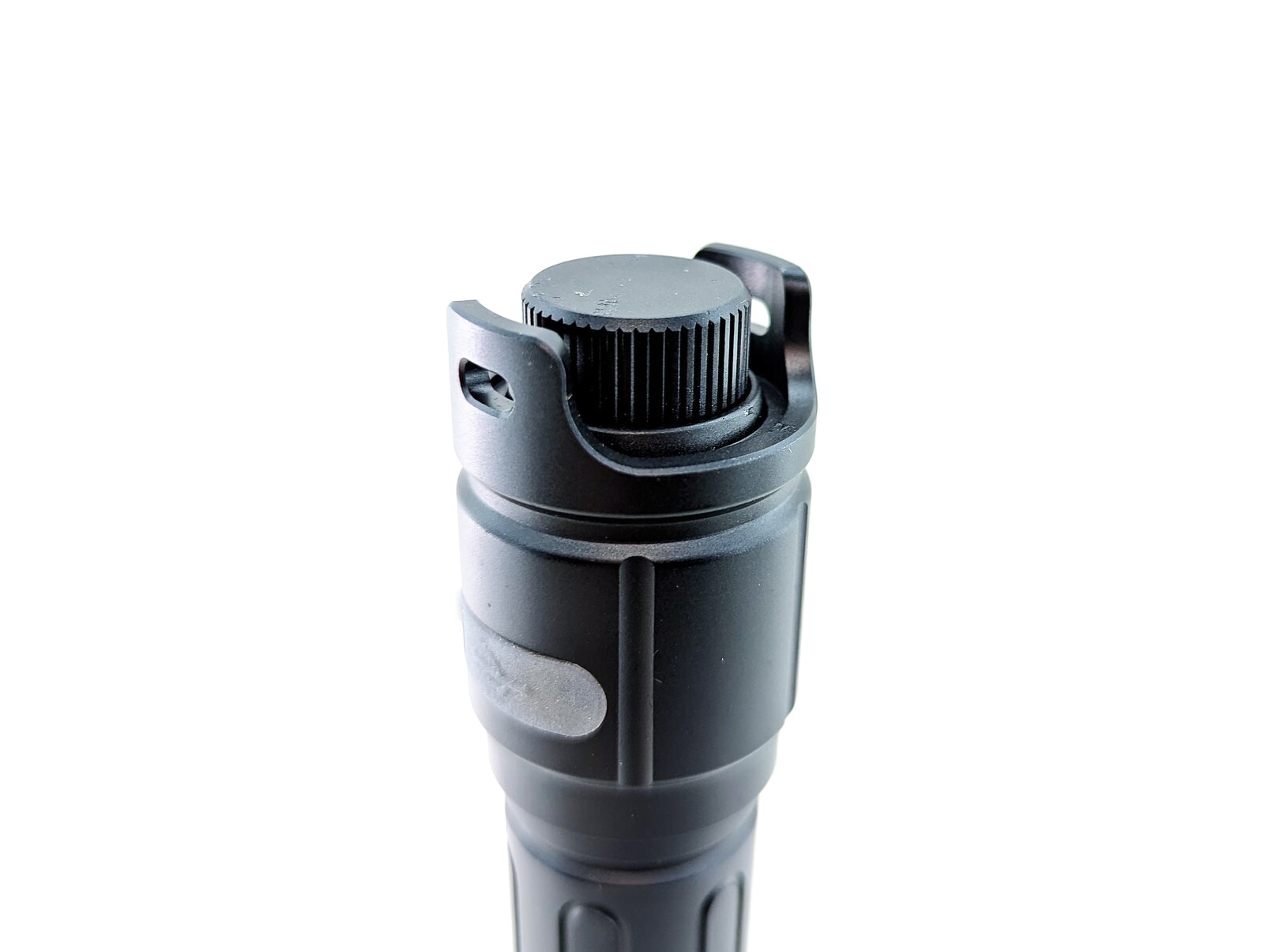
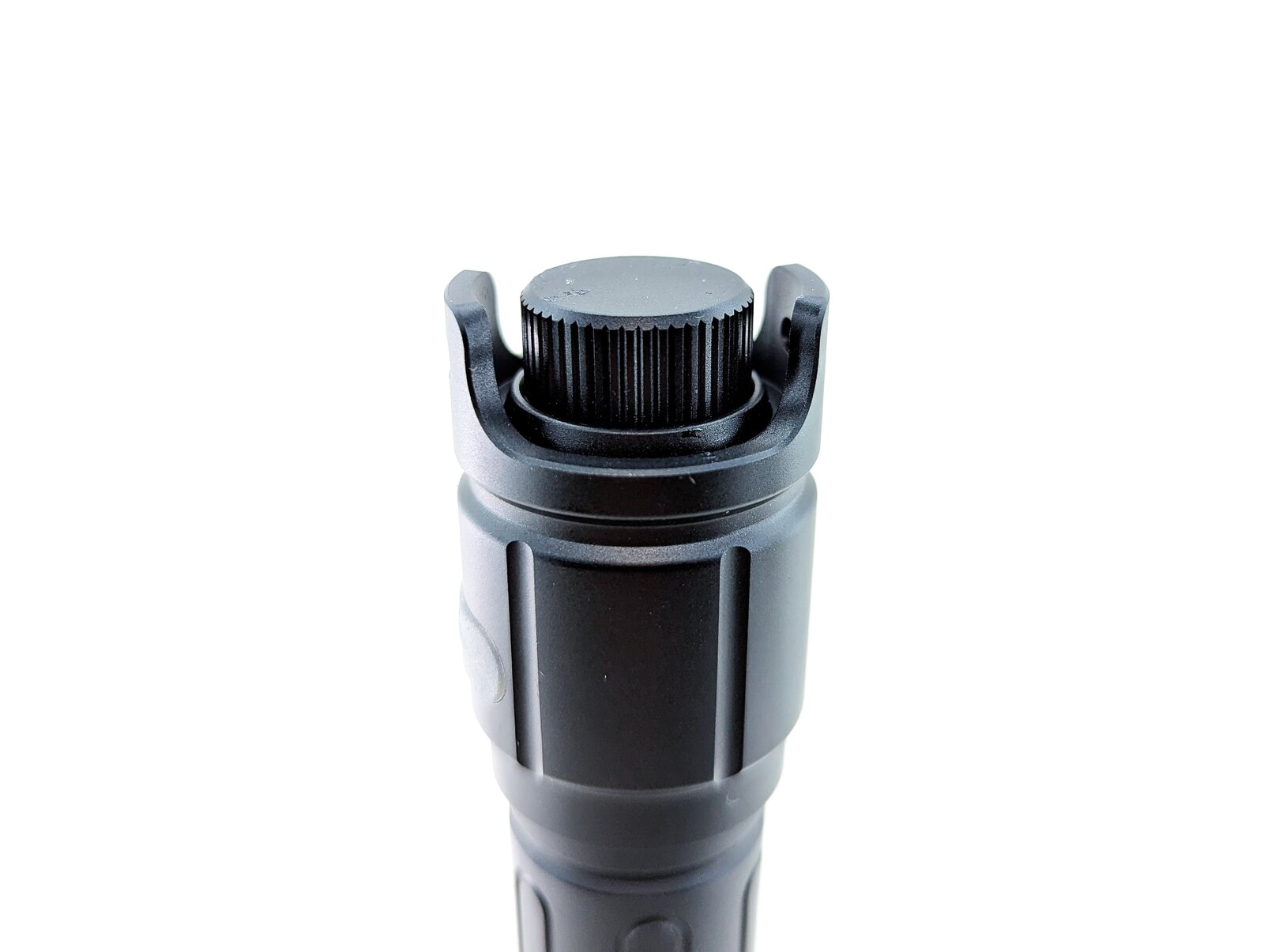
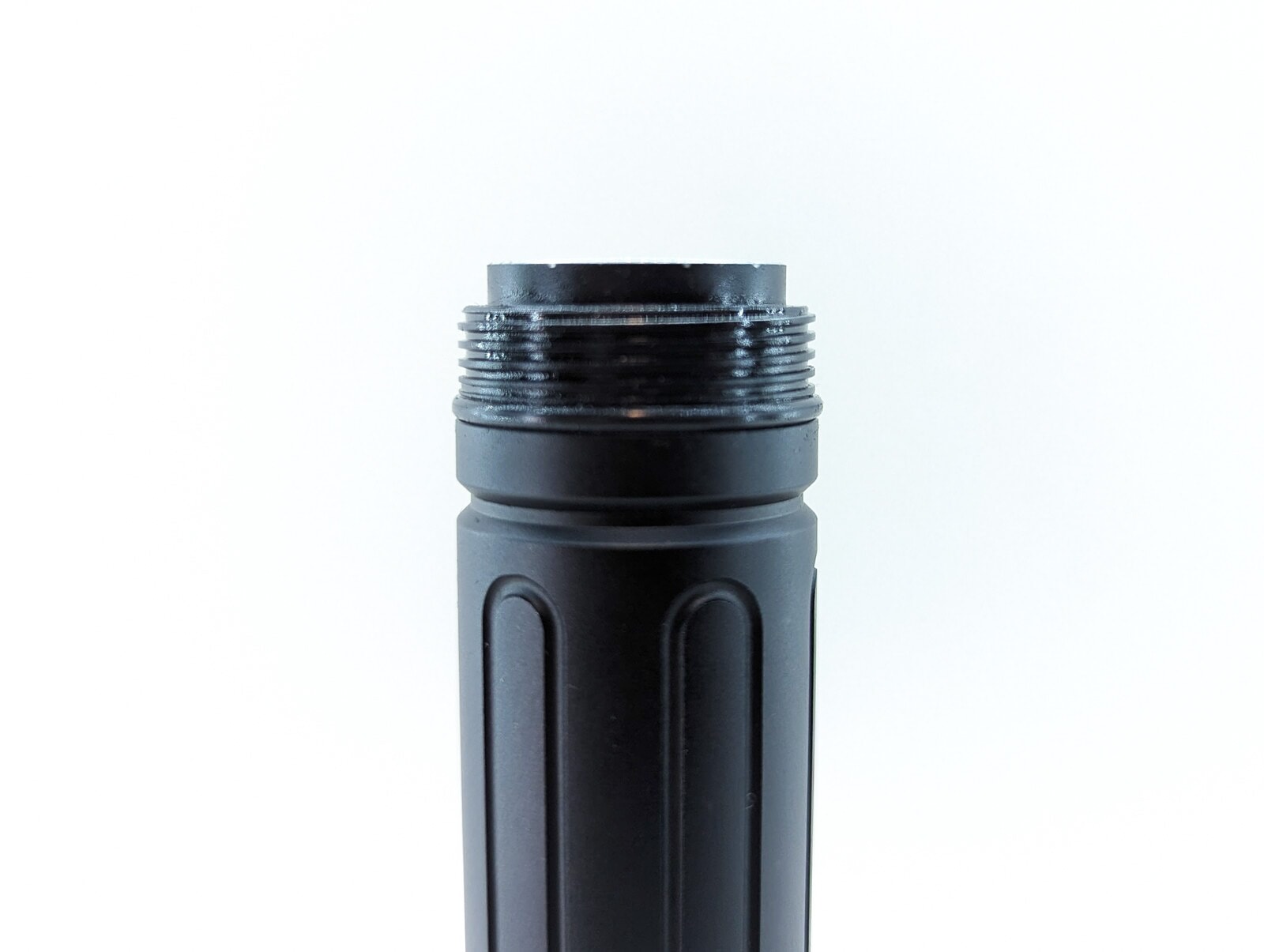
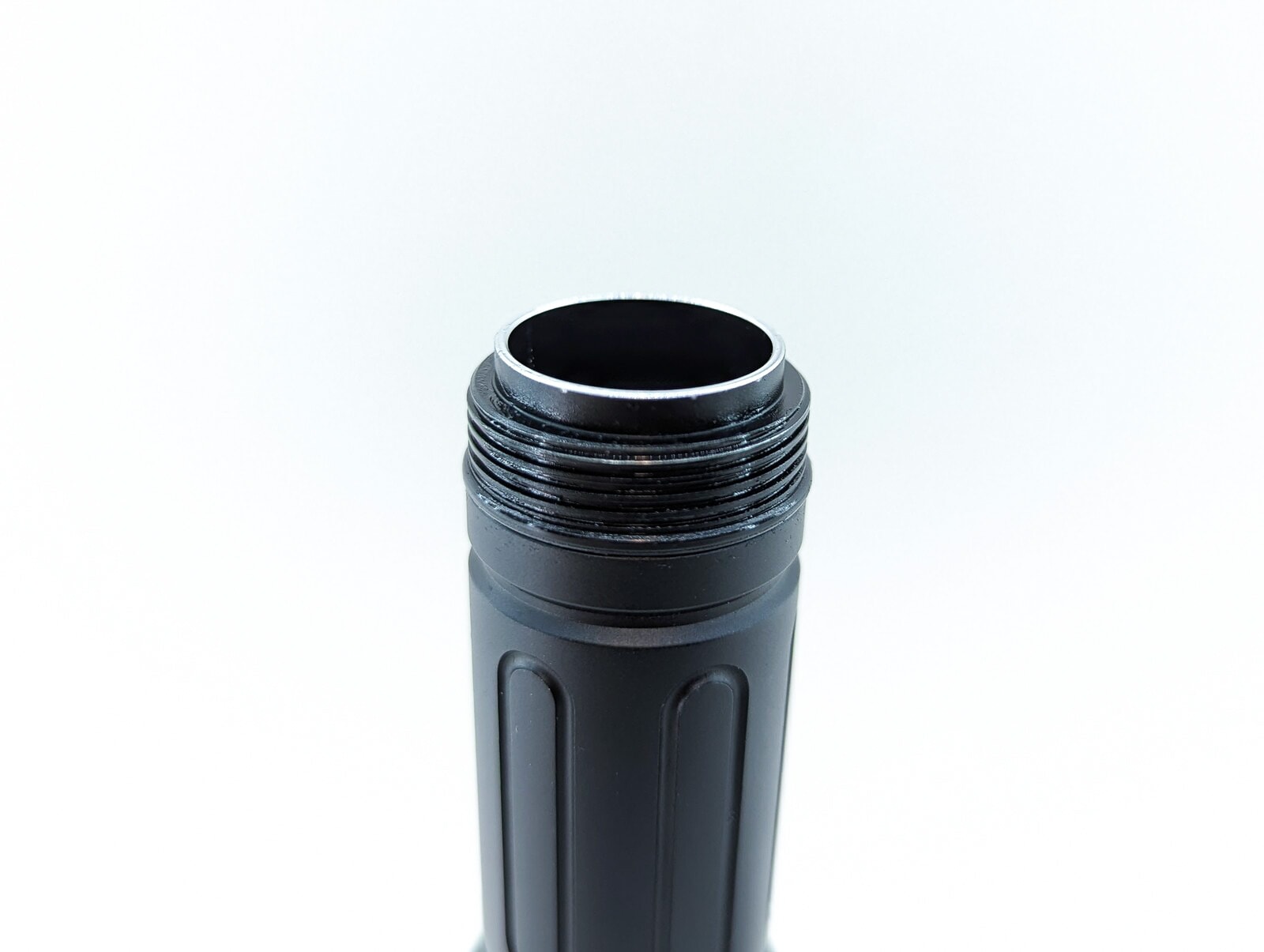

LED, Lens, Bezel, Beam, and Reflector
The star of the Speras TH12 show is the 66mm PMMA optical lens. It is large and can make a nice, tight beam. But you know what happens when you focus a zoomie flashlight? You get a square beam, because you’re projecting the shape of the LED’s die. But wait! Not so with the white LED module – you get a nice, round beam. That’s because the white LED is the “high performance S51” LED. That naming convention doesn’t mean anything to me. However, when looking at the LED, it looks exactly like what people call the “Yinding 5050”. This white LED has a fairly unique round emitting surface.
The other LEDs that Speras included are the Osram Green LED and Osram Red LED. Speras didn’t exactly give us model names/numbers, but they’re both domeless LEDs and seem to be 3030 sizing. The green is probably something like the KP CSLNM1.F1 and red may be a KR CSLNM1.23 LED.
Swapping between the LED modules is pretty typical of other zoomies. You unscrew the head of the light, then twist out the LED module. Screw the new one in, then put the head back on. It’s easy enough, but not something that I really feel like doing on the fly in the field too often.
Using an Opple Light Master, I obtained the following measurement from the white LED module on 100% at 5 meters:
- CCT: 5613K
- CRI: 63.5 Ra
- DUV: +0.0089
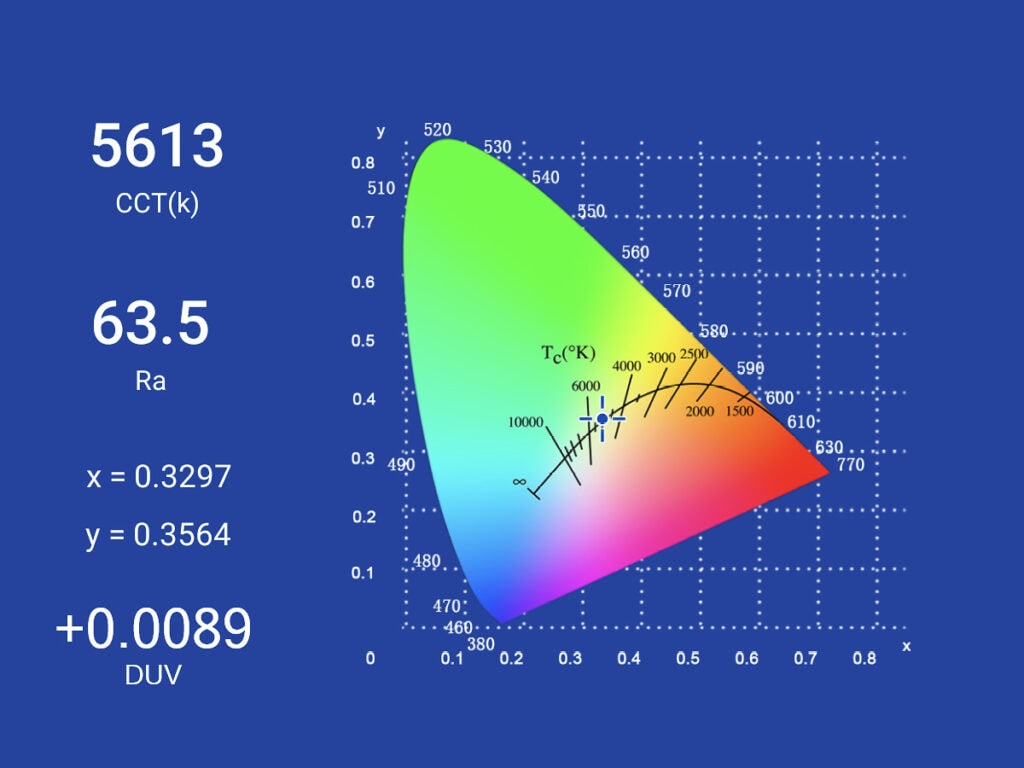
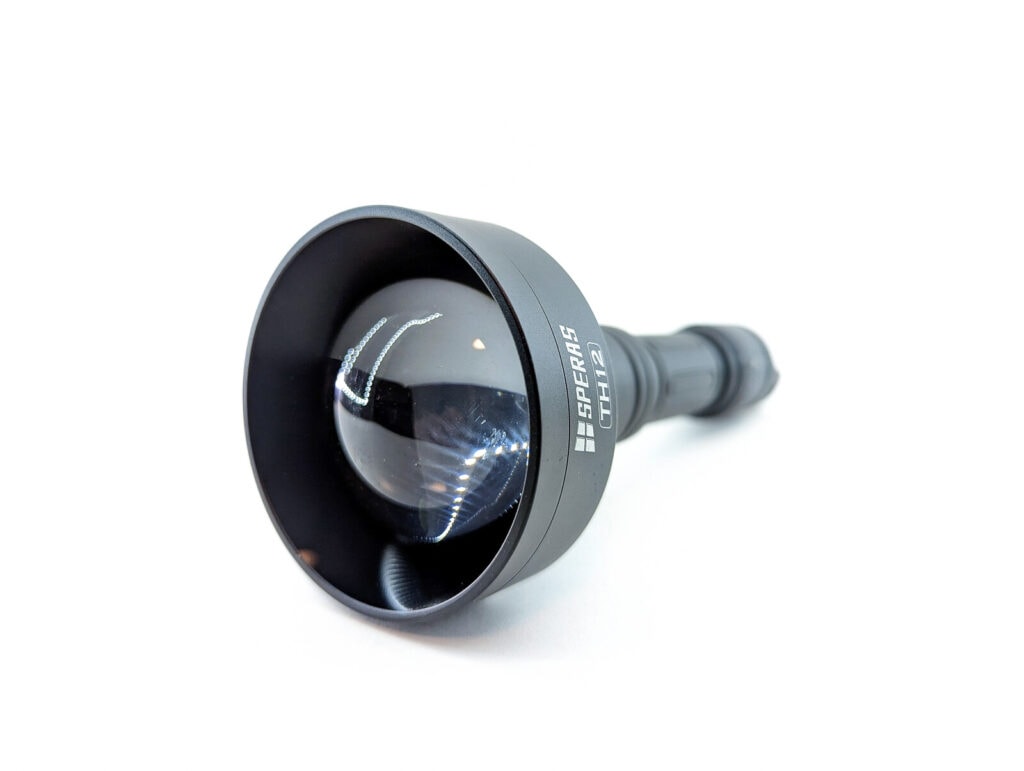
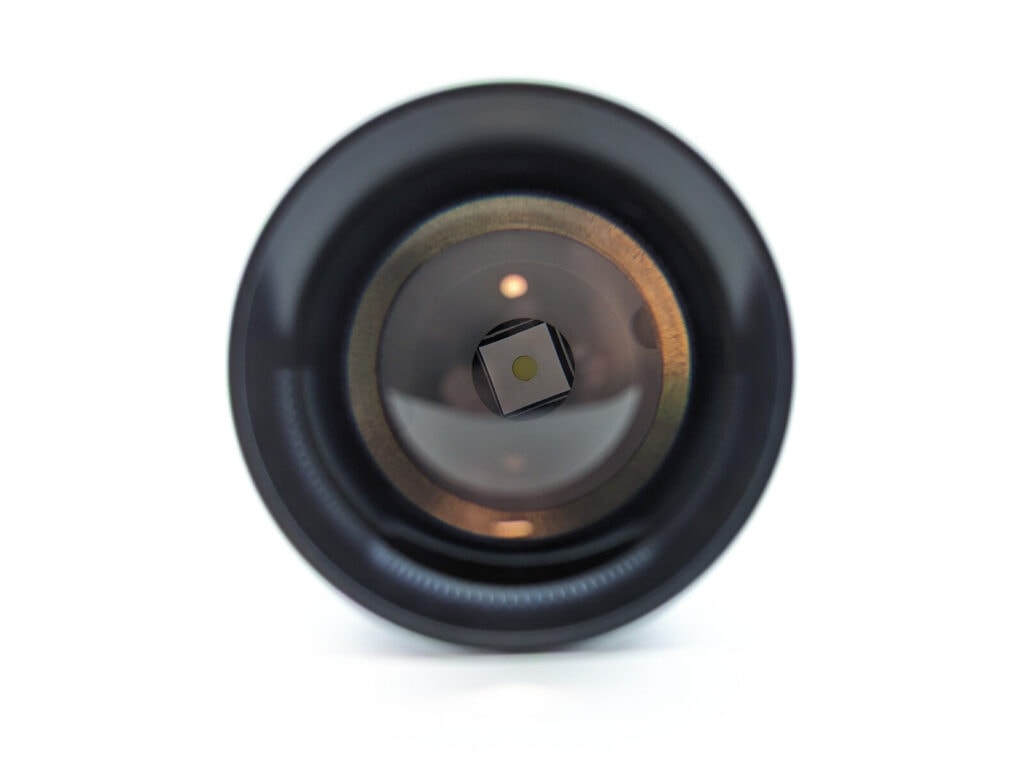
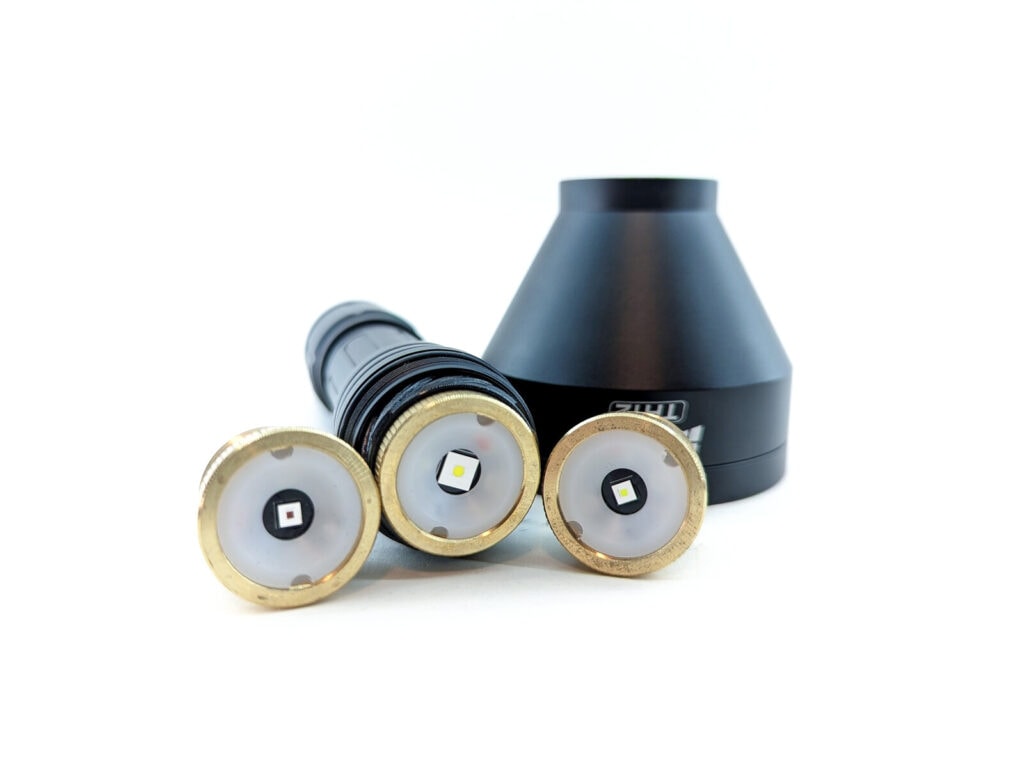
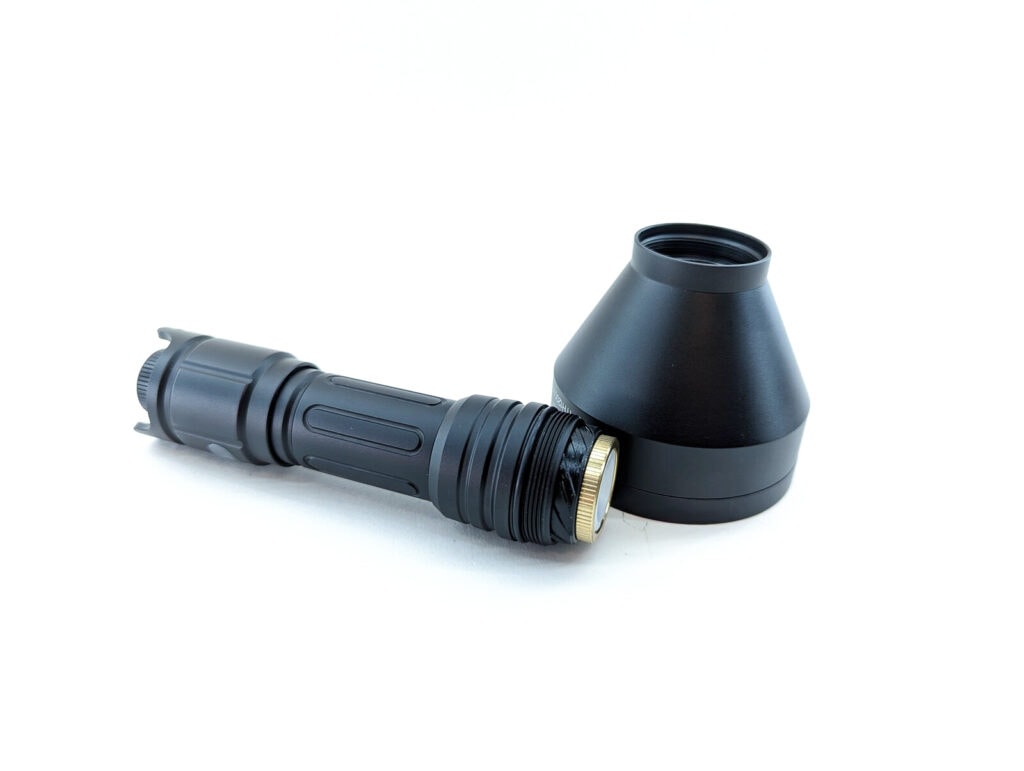
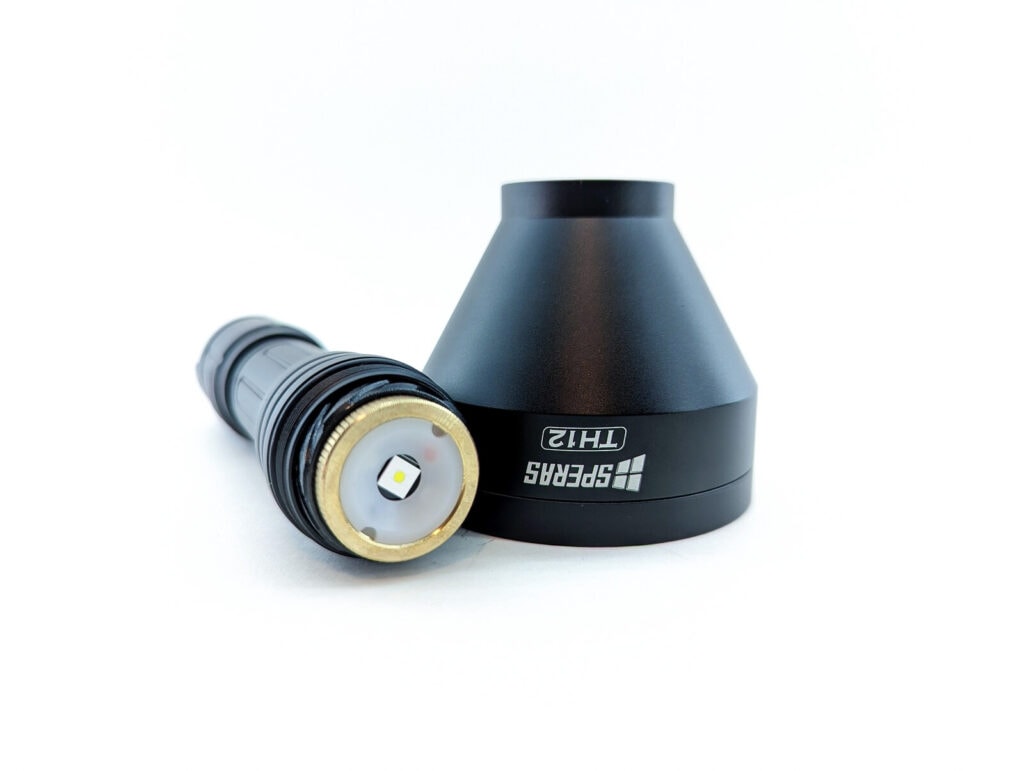
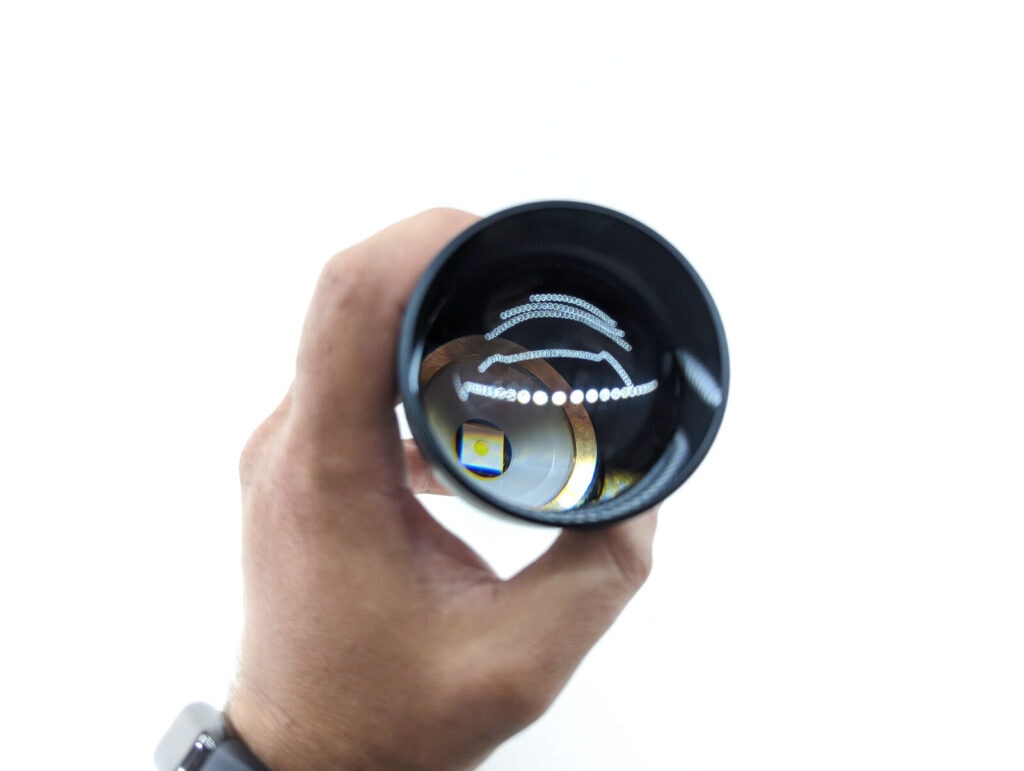
Dimensions and its competition
| Speras TH12 | Millimeters | Inches |
|---|---|---|
| Length, Flood | 178 mm | 7.0 in |
| Length, Focused | 190 mm | 7.5 in |
| Head diameter | 70 mm | 2.8 in |
| Body diameter | 25.4 mm | 1.0 in |
Dimensions are rounded to the nearest millimeter, and to the nearest tenth of an Inch.
Weight:
| Speras TH12 | Weight in grams | Weight in oz |
|---|---|---|
| Without battery: | 264 g | 9.3 oz |
| With battery | 311 g | 11.0 oz |
Weight is rounded to the nearest gram, and to the nearest tenth of an Oz.
Flashlight size comparison with its competition:
Group 1: Speras TH12, Brinyte B158
Group 2: Speras TH12, Mateminco MT35 Mini
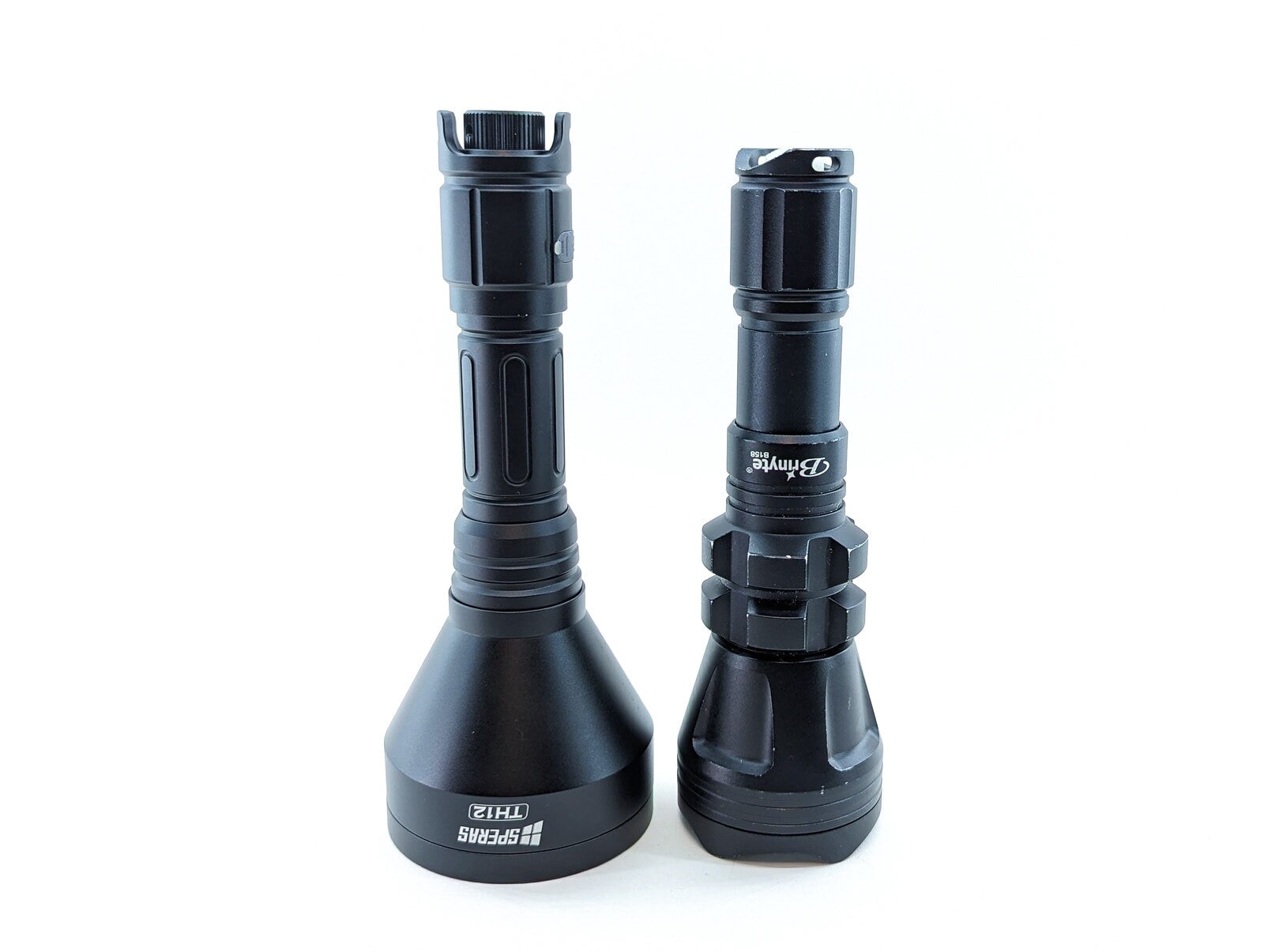
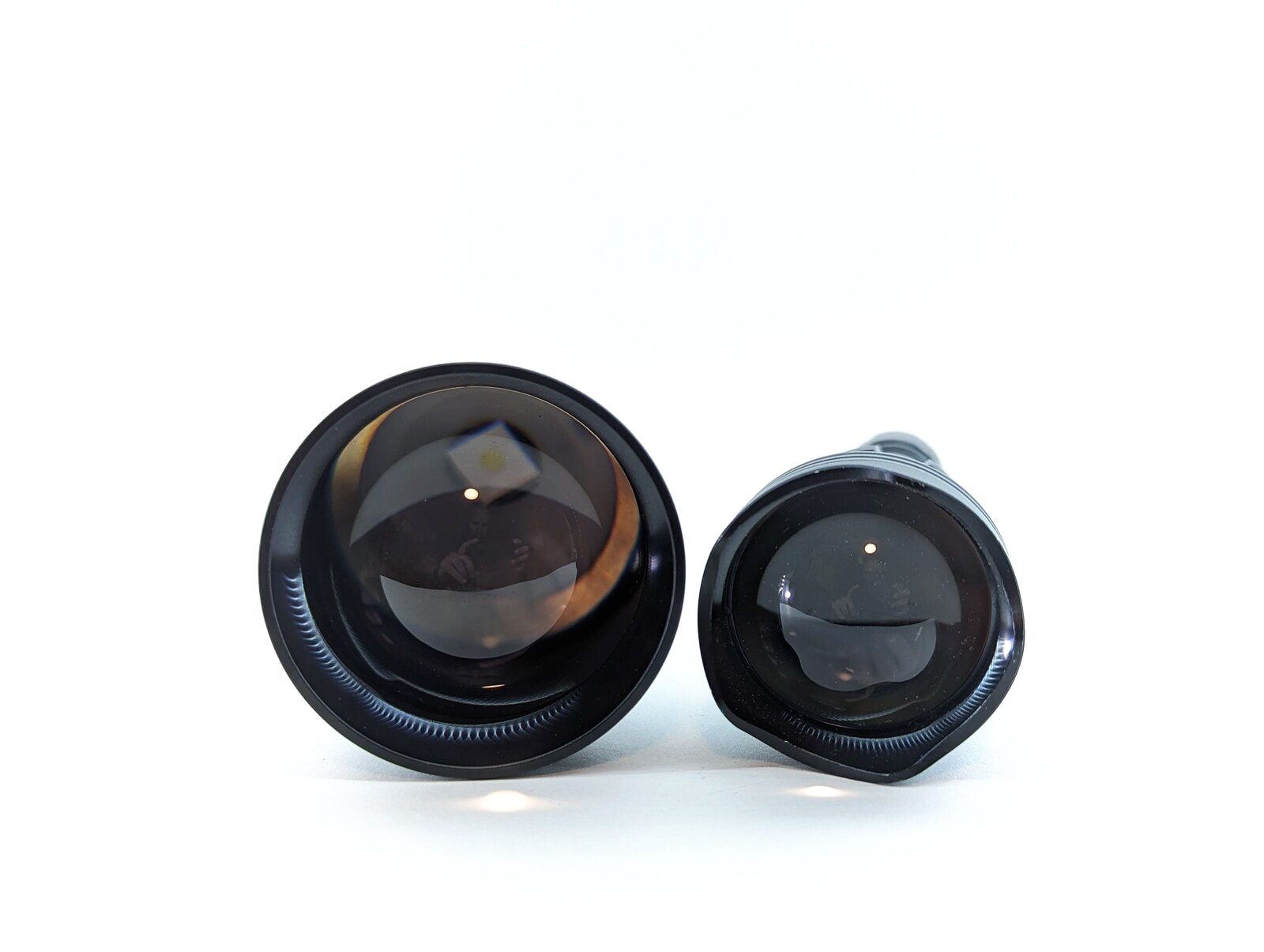

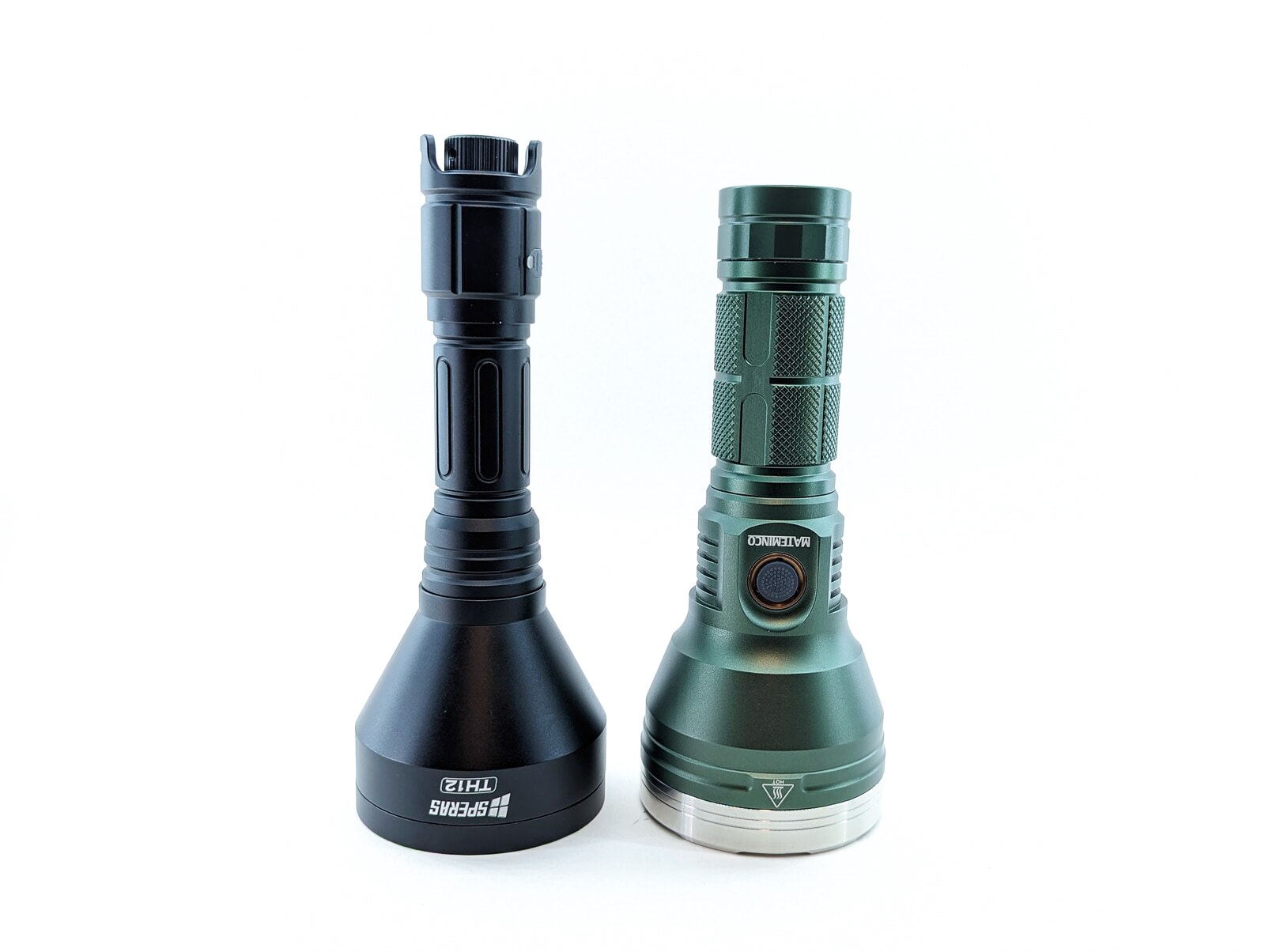
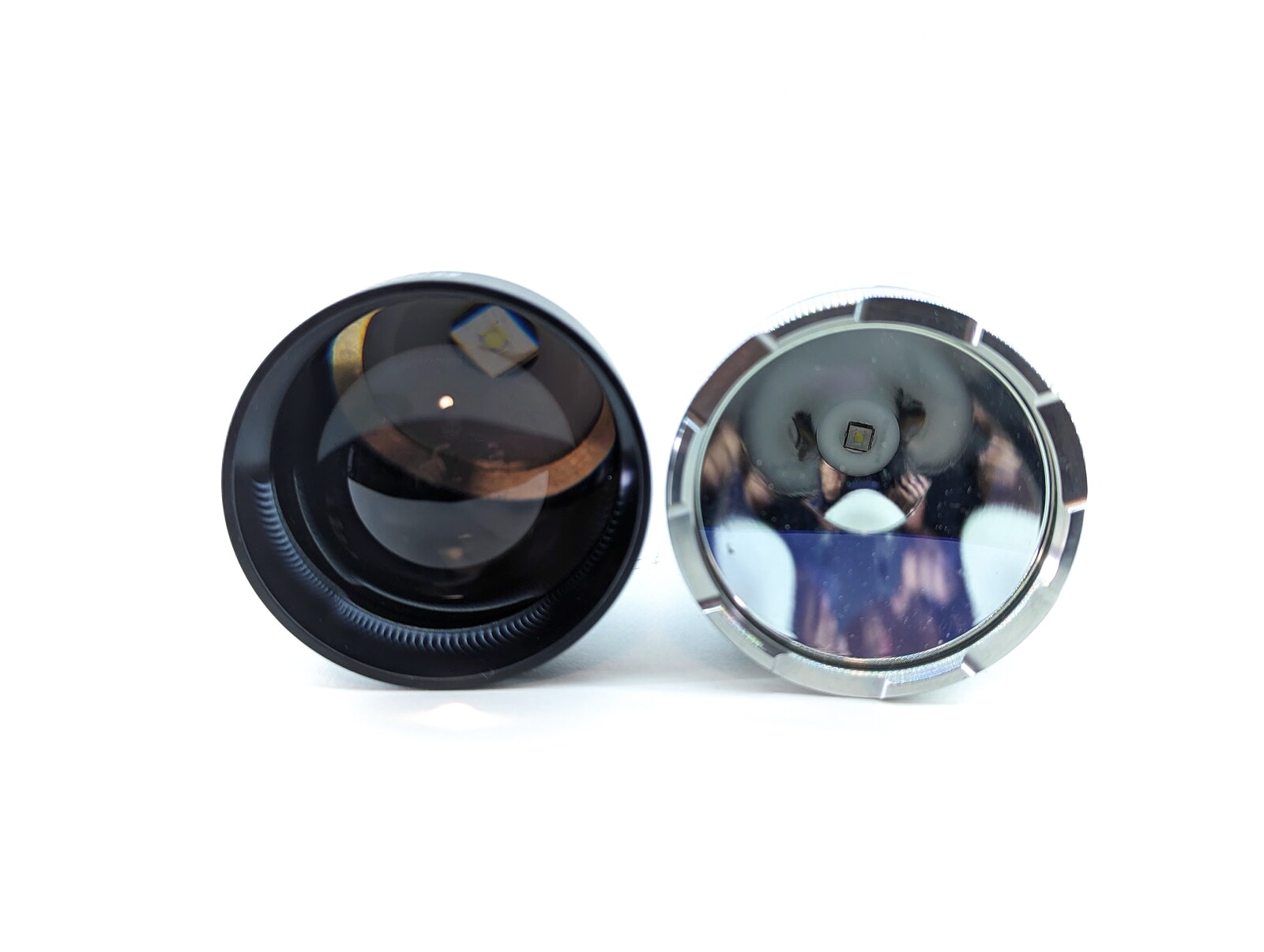
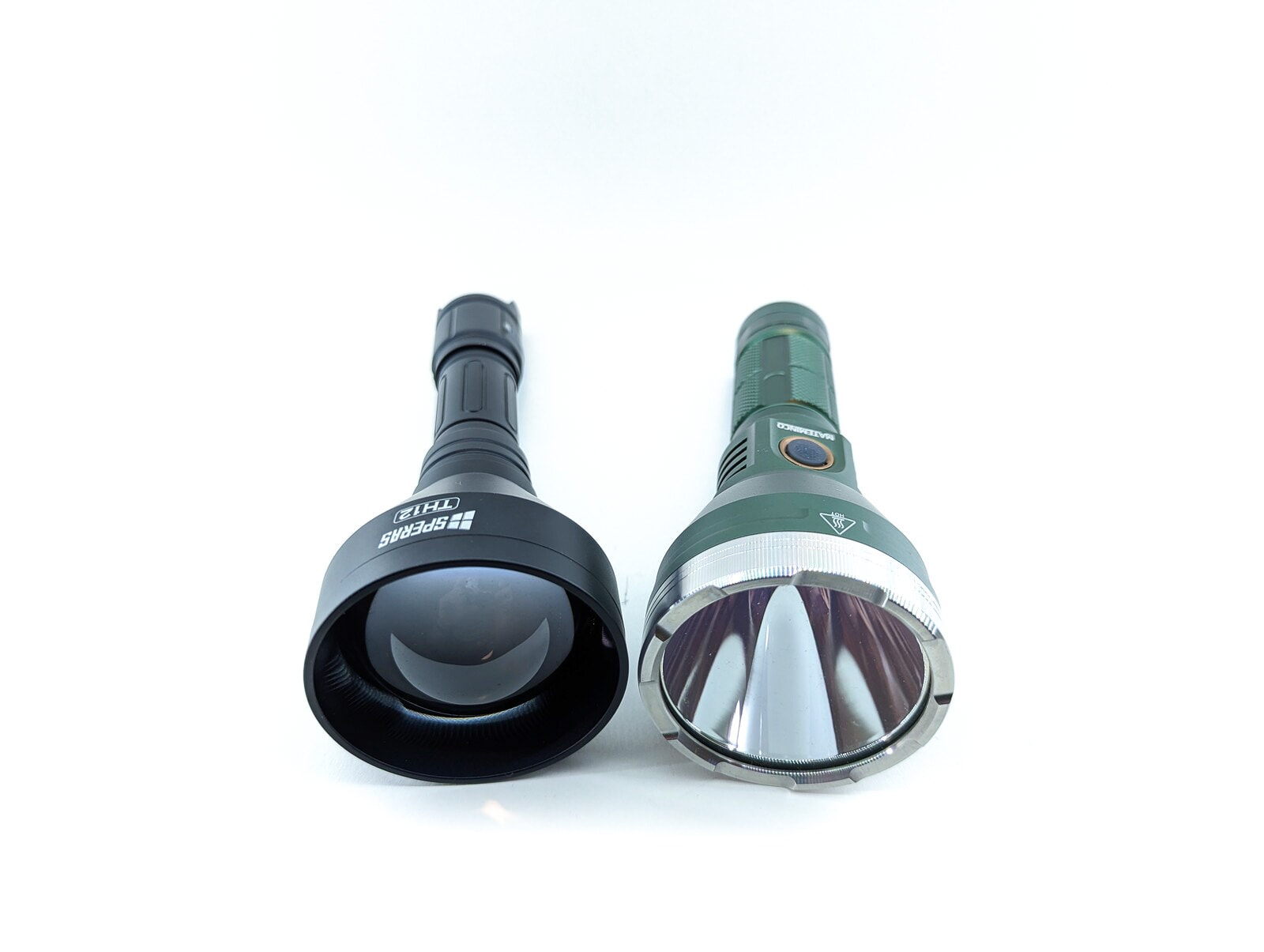
Speras TH12 UI: User Interface and Driver
Available modes:
- Stepless dimming
Available blinky modes:
- None
From OFF:
- Press and hold: momentary on
- Single click: On
- Remote switch S1 button, press and hold: momentary High
- Remote switch S1 button, single click: On in High
- Remote switch S2 button, press and hold: momentary (last used brightness)
- Remote switch S2 button, single click: On in last used brightness
From ON:
- 1 click: Off
- Twist clockwise: increase brightness
- Twist counterclockwise: decrease brightness
- Remote switch S1 button: increase brightness
- Remote switch S2 button: Off
- Remote switch S3 button: decrease brightness
Mode memory:
- No
Shortcuts:
- N/A
Low voltage warning/protection:
- There is a power indicator LED next to the USB port:
- Green: > 30%
- Red: <= 30%
Strobe/blinkies
- N/A
Lock-out mode:
- N/A (can be physically locked out)
PWM
- 1.95 kHz PWM detect by DMM on Hz setting with a photodiode, PWM confirmed by eyesight
- The PWM is clearly audible
Additional/summary info on the UI:
- Aside from the remote switch, using the TH12 is about as easy as it gets. Press for on/off, twist to increase/decrease brightness.
Speras TH12 Charging and batteries
The Speras TH12 kit comes with a Speras-branded 18650 battery, the “EB31”. It’s a protected battery with a slight button top, clocking in at 3100 mAh (11.47 Wh). There are springs on both the driver and tailcap, so the TH12 is pretty accommodating when it comes to batteries. I threw a flat-top Samsung 30Q in the flashlight and it worked just fine. I even pounded it against my palm to try and get it to misbehave with the shorter battery. While it rattled a little bit, the light from the TH12 never seemed to flicker and never turned off.
The Speras TH12 features built-in USB-C charging and comes with a USB-A to USB-C cable. The specs say that the flashlight supports 5V / 1A charging, and my tests confirm that. I observed 5.07 watt charging (1.0 amps @ 5.08 volts). The ending battery voltage was 4.18 and the charge time was 5 hours and 21 minutes. I’m glad that there’s built-in USB-C charging; it’s a great feature to have. But it seems like 5+ hours is a bit slow for a 18650 battery.
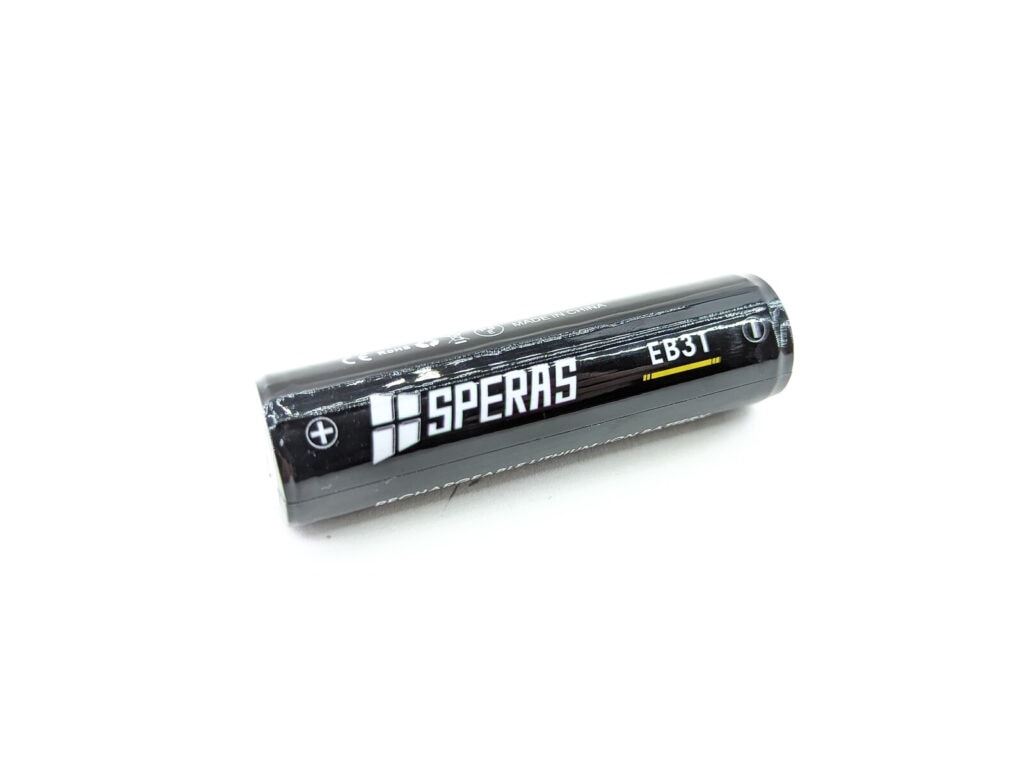

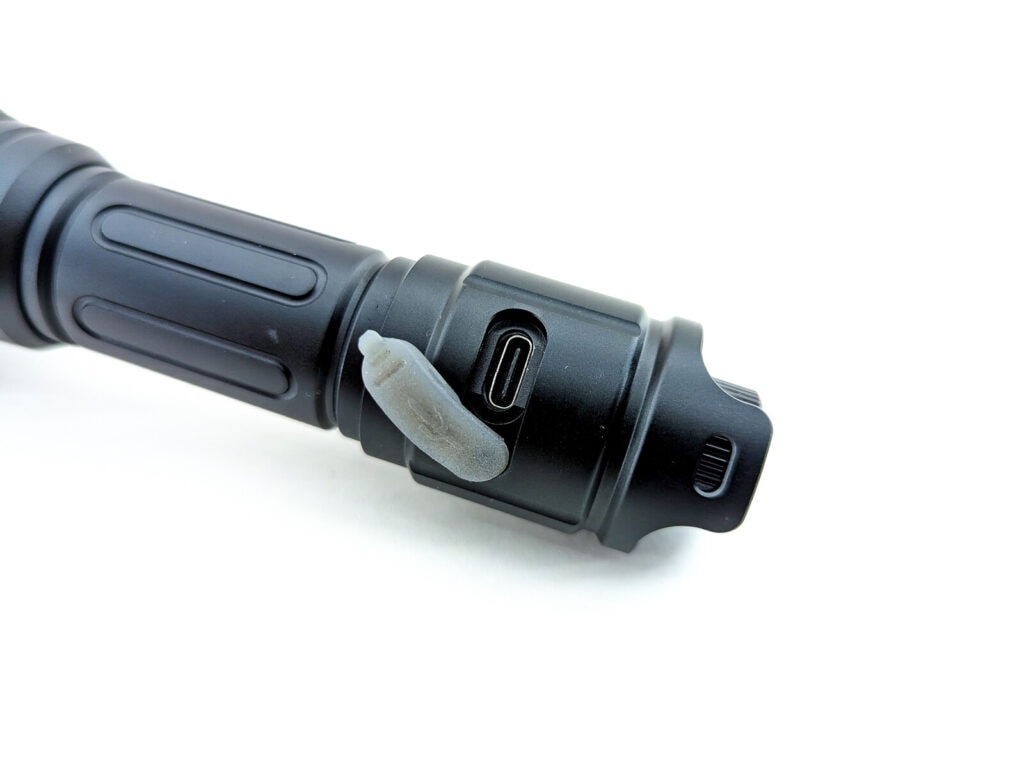
Performance test
Lumen measurements
How Lumens are Measured: Understanding ANSI FL1 Standards How Lumens are Measured: Understanding ANSI FL1 Standards: The ANSI FL1 standards specify that output in lumens should be measured 30 seconds after turning on, as this is the standardized time for measuring brightness according to the industry standard. This is why we focus on this part in our measurements. The ANSI FL1 standards require an ambient temperature of 22 ± 3°C. We record the ambient the ambient temperature to identify potential reasons for any observed discrepancies.Lux was measured by a UNI-T UT383 BT at 10 meters. Lumens were measured in a homemade lumen tube using a VEML7700 sensor, calibrated with a calibration light provided by 1Lumen. The included Speras-branded battery was used for testing.
| Mode | Specs | turn on | 30 sec | 10 minutes |
| White, flood, low | 20 lm | 6.2 lm | 6.5 lm | – |
| White, flood, high | 600 lm | 398 lm | 390 lm | 222 lm |
| White, focus, low | 10 lm | 5.5 lm | 5.5 lm | – |
| White, focus, high | 400 lm | 299 lm | 293 lm | – |
| Green, flood, low | 20 lm | 5.4 lm | 5.4 lm | – |
| Green, flood, high | 600 lm | 279 lm | 273 lm | 262 lm |
| Green, focus, low | 10 lm | 4.6 lm | 4.6 lm | – |
| Green, focus, high | 400 lm | 196 lm | 189 lm | – |
| Red, flood, low | 5 lm | 2.4 lm | 2.4 lm | – |
| Red, flood, high | 200 lm | 69 lm | 64 lm | 37 |
| Red, focus, low | 3 lm | 1.8 lm | 1.8 lm | – |
| Red, focus, high | 100 lm | 51 lm | 48 lm | – |
Parasitic drain:
- N/A – couldn’t test due to flashlight design
Zoomie lights really aren’t known for being high output. A lot of light just ends up being absorbed inside the flashlight and doesn’t make it out the front. Even so, 600 lumens sounds reasonable, right? Well, in this case I guess it’s too good to be true. In white flood mode, I measured around 400 lumens which is only 67% of spec. Every measurement across the board was well below spec, which I’m honestly a bit shocked at.
Speras TH12 Battery Life: Runtime graphs
How Runtimes are Measured: Understanding ANSI FL1 Standards About ANSI FL1 runtime standards: The runtime is measured until the light drops to 10% of its initial output (30 seconds after turning on). This does not mean that the flashlight is not usable anymore. The last column shows how long the light actually works till it shuts off. If there is a + symbol, it means that the test was stopped at that particular point, but the light was actually still running. This happens on certain occasions, with certain drivers, firmware, or batteries.| Mode | Specified runtime | Measured runtime ANSI | Time till shut off |
|---|---|---|---|
| White, high | 2h 24min | 2h 21min | 2h 21min |
| White, low | 48h | ||
| Green, high | 2h 24min | 3h 24min | 3h 24min |
| Green, low | 48h | ||
| Red, high | 2h 24min | 2h 26min | 2h 26min |
| Red, low | 48h |
The White and Red runtime numbers are a near-perfect match to the spec’ed times and Green ran for considerably longer. It’s good to see one of the specs be accurate.
The runtime test also revealed two things. First, there appears to be some sort of thermal regulation going on, kicking in at 45°C. Secondly, it looks like the Speras TH12 is using a FET-only driver. For all three LED modules, the output dropped as the battery voltage slowly decreased. Driving LEDs through a MOSFET isn’t terrible, but it’s not very efficient (especially for red, with its low forward voltage) and it’s pretty much the cheapest you can go besides using a plain ol’ resistor. With a brand like Speras, I was hoping for better electronics – like perhaps a proper buck driver.
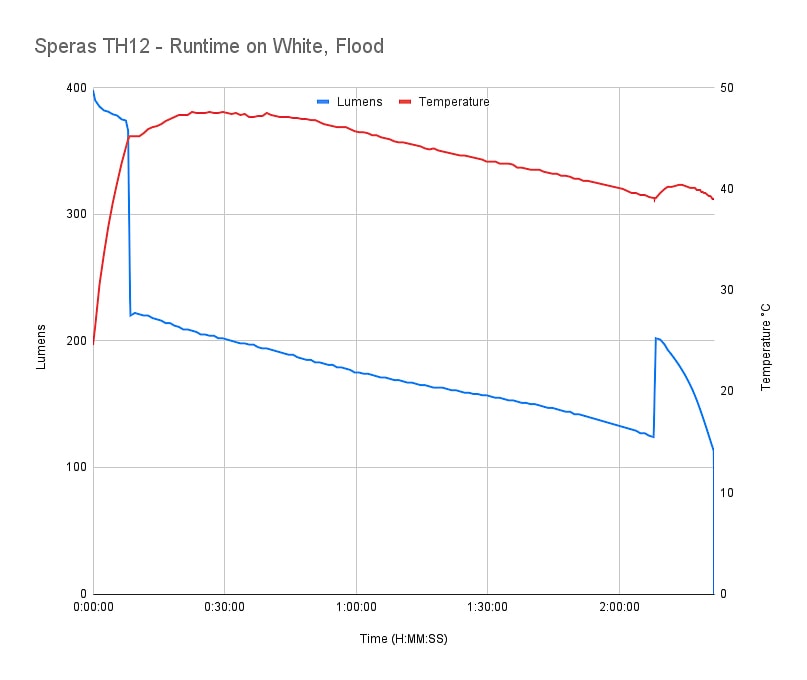
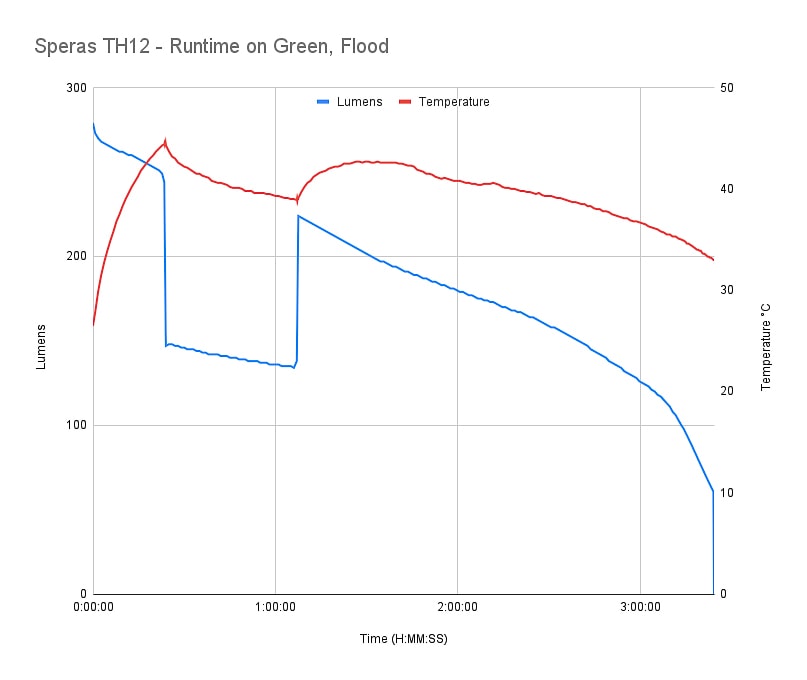
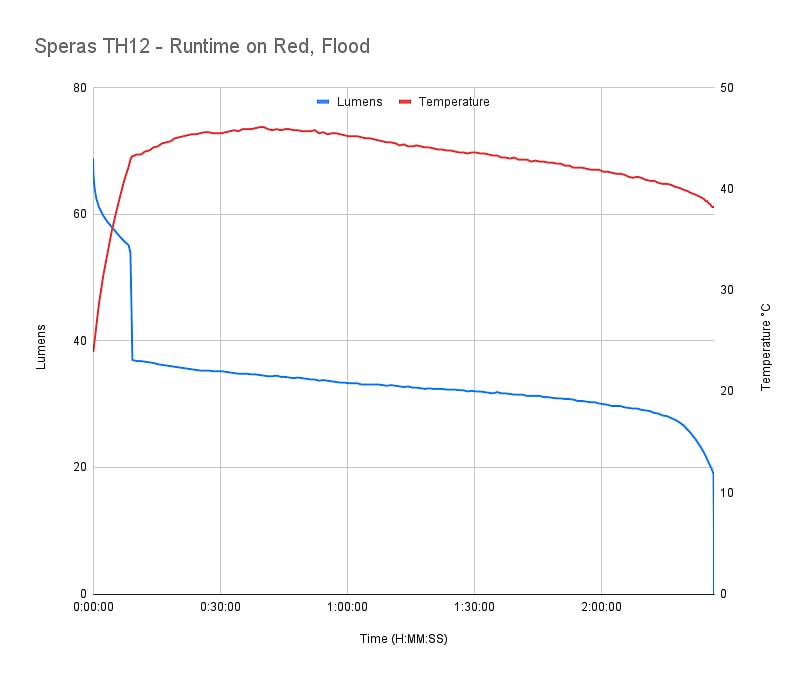
Peak beam intensity and beam distance measurements
About Peak beam intensity: Understanding ANSI FL1 Standards About peak beam intensity The calculated value of distance in meters at which the flashlight produces a light intensity of 0.25 lux. (0.25 lux is about the brightness of a full moon shining on an object). This means that the intensity has decreased so much, it becomes difficult to see darker objects, or objects that don’t reflect light. The columns ‘Meters’ and ‘Yards’ use rounded numbers.Intensity was measured at 10 meters after being turned on for 30 seconds. A UNI-T UT383 BT lux meter was used.
| Mode | Specs | Candela measured | Meters | Yards |
|---|---|---|---|---|
| White, focus, high | 366,480 cd | 393,700 cd | 1,255 m | 1,372 yd |
| Green, focus, high | 705,600 cd | 460,900 cd | 1,358 m | 1,485 yd |
| Red, focus, high | 170,000 cd | 188,100 cd | 867 m | 949 yd |
Does the Speras TH12 throw a long way? Yes, it sure does! The white and red LED met/exceeded expectations. Sadly, the green LED fell far short of spec.
Beamshots
Camera settings and distance:
Beam shots of the building are taken at 50 m (55 yd) using a Pixel 7 set to ISO 800 with 1/20 second exposure time
Beamshots of the following flashlights compared:
- Speras TH12 White, focus
- Speras TH12 White, flood
- Speras TH12 Green, focus
- Speras TH12 Green, flood
- Speras TH12 Red, focus
- Speras TH12 Red, flood
- Astrolux FT03S SBT90.2
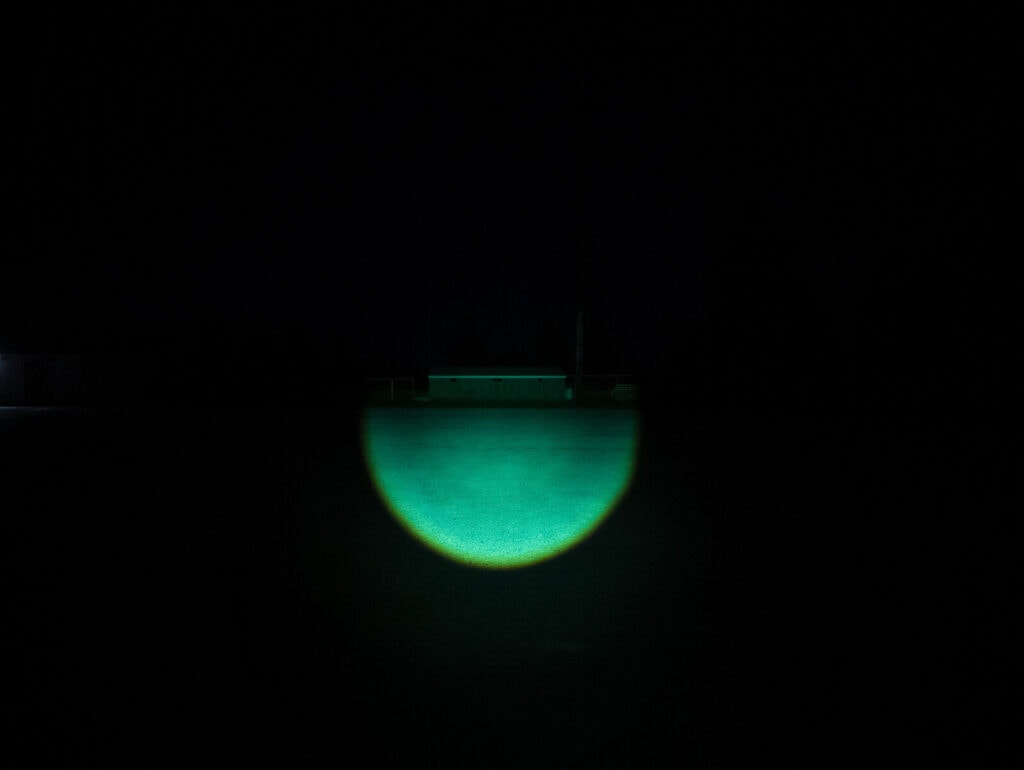

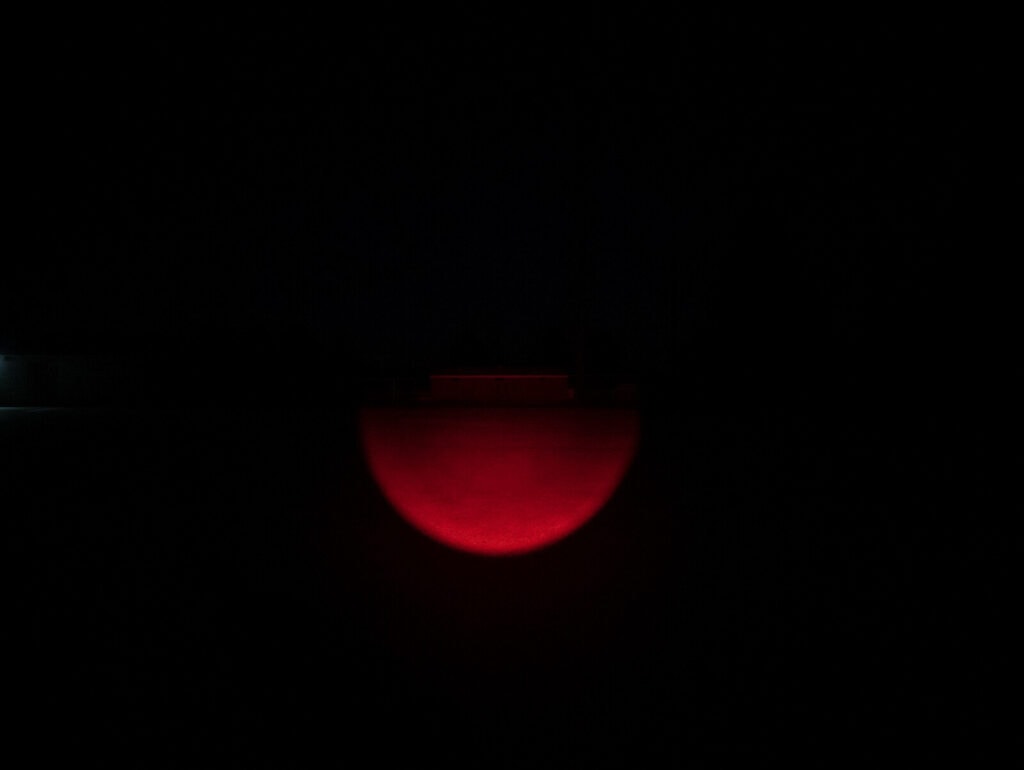
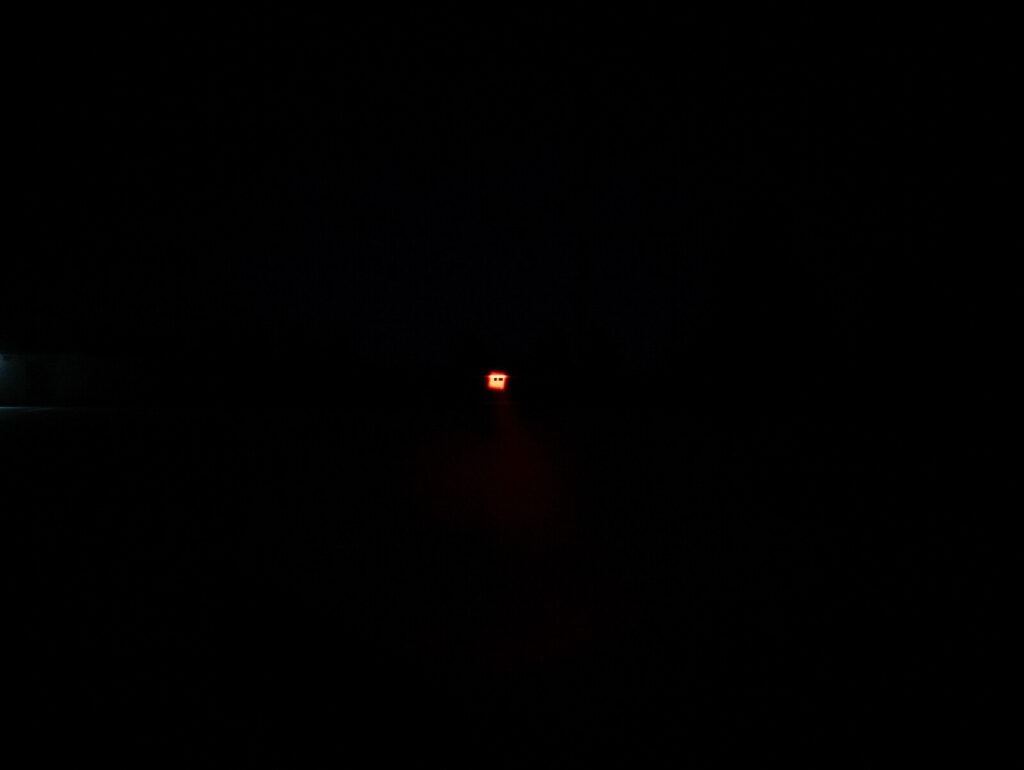
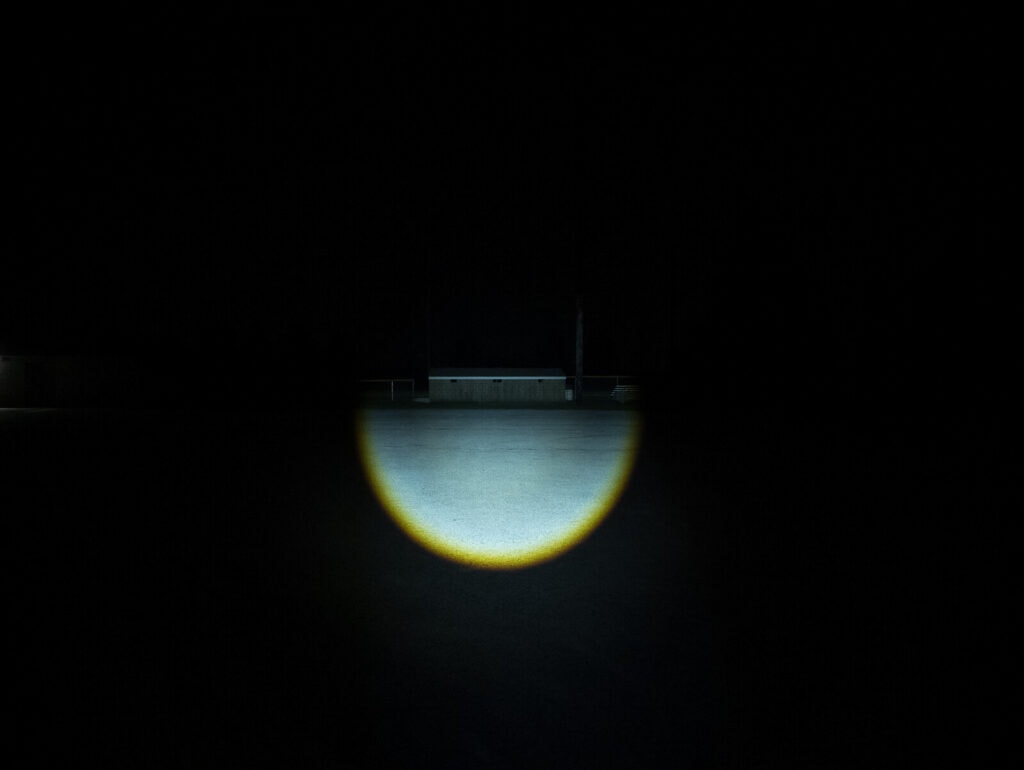
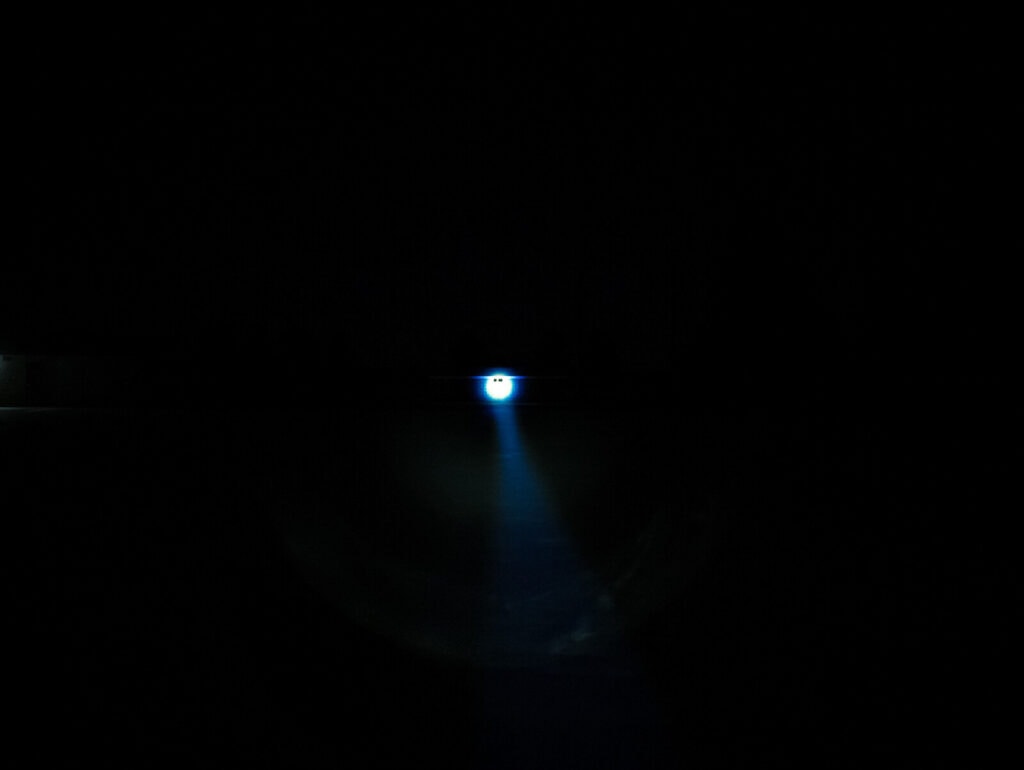
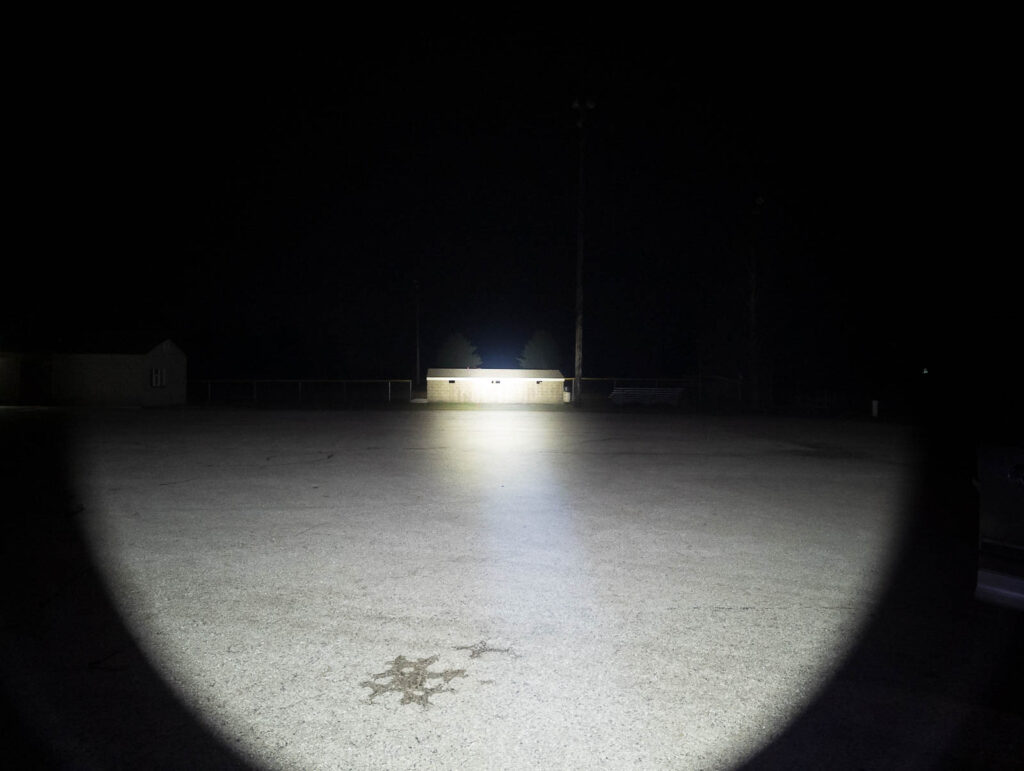
Disclaimer: This flashlight was sent to me for review at no cost by Speras. I have not been paid to review, nor have I been holding back on problems or defects.
Final Verdict
Pros
- Solid (physical) build quality
- Smooth zooming action
- Three LED modules/colors
- Well rounded kit
- USB-C charging
- Easy to use
Cons
- Misses output specs
- Slow, audible PWM
- Unregulated output (PWM’ed FET)
Explanation on star ratings:
1: Avoid: a match would be a better choice – 2: Poor: significant defect or issues; almost unusable – 3: Average: some defects or issues; but still usable 4: Good: recommended (minor issues) – 5: Great: highly recommended

3.5 stars: ★★★⋆
While our star rating provides a reliable indicator, we encourage you to read the full review to make an informed decision based on your own needs and preferences.
Physically speaking, the Speras TH12 is a really nice light. The machining and anodizing are really well done. The zooming action is quick and smooth (unlike some other zoomie’s I’ve owned/built… looking at you, UF-1504). And overall, Speras has put together a very nice kit for hunting: white, red, and green LED modules, scope clamp, and a remote pressure switch all arranged in a handy carrying case (even if mine did arrive broken).
There are several items, though, that temper my excitement for this flashlight. First off, it really missed the output specs. Secondly, the driver appears to be just a slowly PWM’ed MOSFET – no constant-current circuitry. Compared to a lot of hunting lights that you could buy, I’m sure that many would fall short of what the Speras TH12 offers. I still expected more from Speras, though.
Buy your Speras here:
1lumen selects and reviews products personally. We may earn affiliate commissions through our links, which help support our testing.